The Life of an Itinerant through a Pinhole
By Behzad Khosravi Noori
From 1956 to 1968, the photographer Gholamreza Amirbegi captured a wealth of images from around his neighborhood in southwestern Tehran, documenting a diverse range of urban subjects. At the time the photographs were taken, the city had just seen a major influx of working-class immigrants from the country’s smaller municipalities—an effect of the Second World War and the economic devastation that accompanied the Anglo-Soviet occupation of Iran. The identities of this social group predominate Gholamreza’s photographs. Only recently unearthed, the archive of images reveals the era’s shifting relationships between global and local subjectivities of image production. By re-narrating these materials, which evoke not only particular, local memories, but also distinct subaltern histories, this overlooked archive tells stories of social change from below in contemporary Iran, as seen in the relationships of Gholamreza’s subjects to global cinematic images, unconscious colonial memory, and the means of production.
Framed by a historical analysis of these archival images, this exposition’s overlapping fragments illustrate shifting relationships. In so doing, they introduce and reinforce the necessity of itinerancy—not simply that of the photographer, Gholamreza, but of the image itself as a global traveler that discloses histories of colonization and their effects on contemporary social and political conditions. Moreover, this exposition highlights the absence of representation of the subaltern in the realm of contemporary art in Iran, as well as in the modern Iranian nation-state’s attempts to construct a domestic “primitive” people as a fool to a Tehran-centric national culture.
By applying a comparative historical-material analysis, my aim here is to develop a multi-sited archaeology of contemporary history. I explore possible correspondences between (and within) societies that share interconnected histories, taking into account unconscious colonial memory and proletarianism, as well as their underlying technologies of image production. I thus propose a transformation of the merely historical interpretation of everyday perception—all too often taken for granted—into an archaeological one: the prestigious and valuable object. This approach begins with an excavation of the historical materials themselves, in order to both discover lost identities in these images, and to displace them from sedimented historical positions. In doing this, I address the question: What happens to the past from the vantage point of the future?
The City of My Birth
In 1932, when I was abroad, it began to be clear to me that I would soon have to bid a long, perhaps lasting farewell to the city of my birth.
—Walter Benjamin, on Berlin
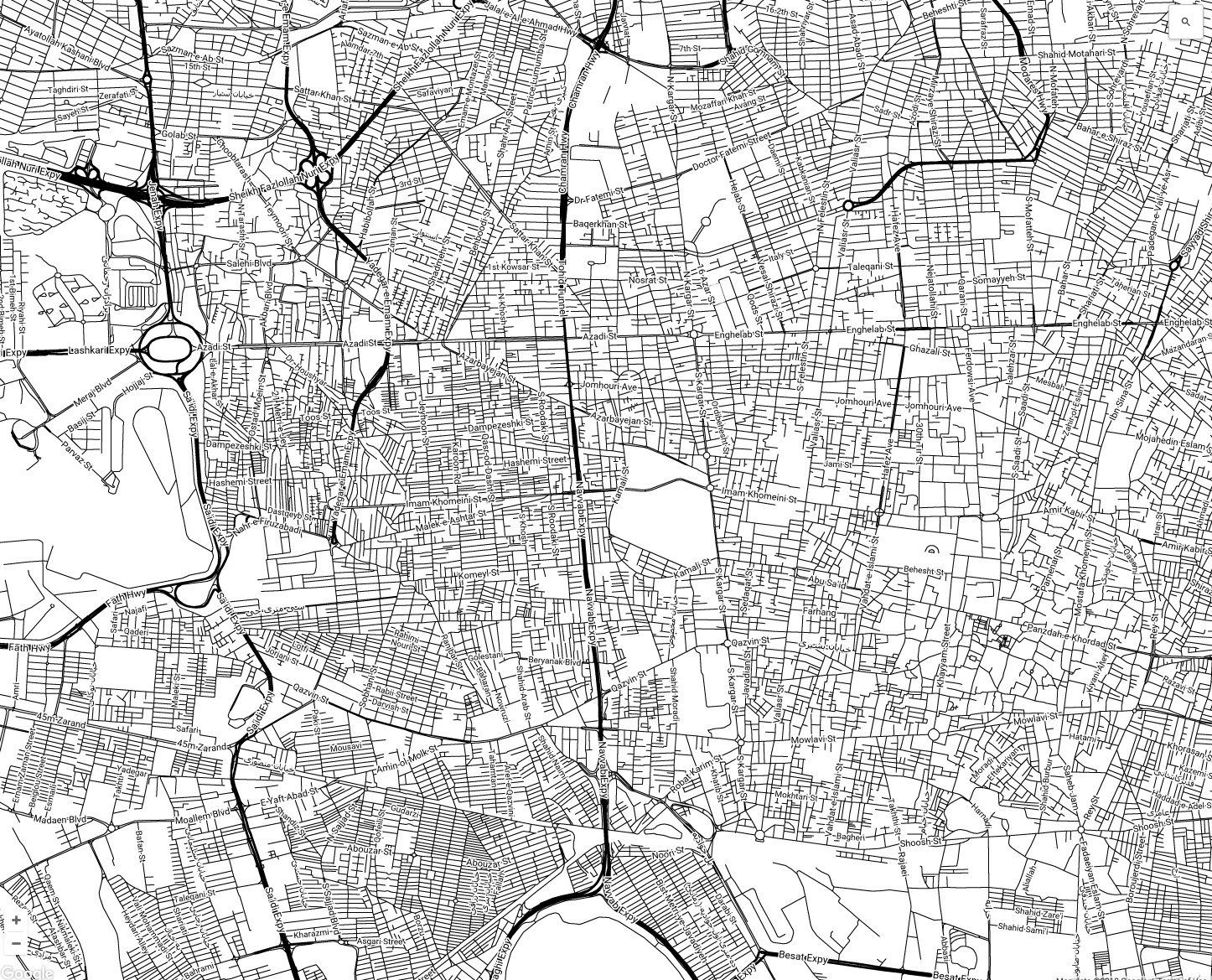
She asks: Do you like them? They’re amazing! I reply.
It’s a winter evening, and the shadows are tall. We are standing in the tiny room that was my grandfather’s, two years after his death. I know my grandmother can see how enthusiastic I am about the photo negatives that she has taken from one of her family albums.
She limps out of the room, supporting her back with her left hand, and returns several minutes later with an old plastic bag. The bag is full of dark images—photo negatives, printed on paper.
She says: These are your grandfather’s photos.
She says: I wanted to throw them away.
She says: I cannot recognize the people in them.
She says: Their faces are so dark.
She says: You can keep them.
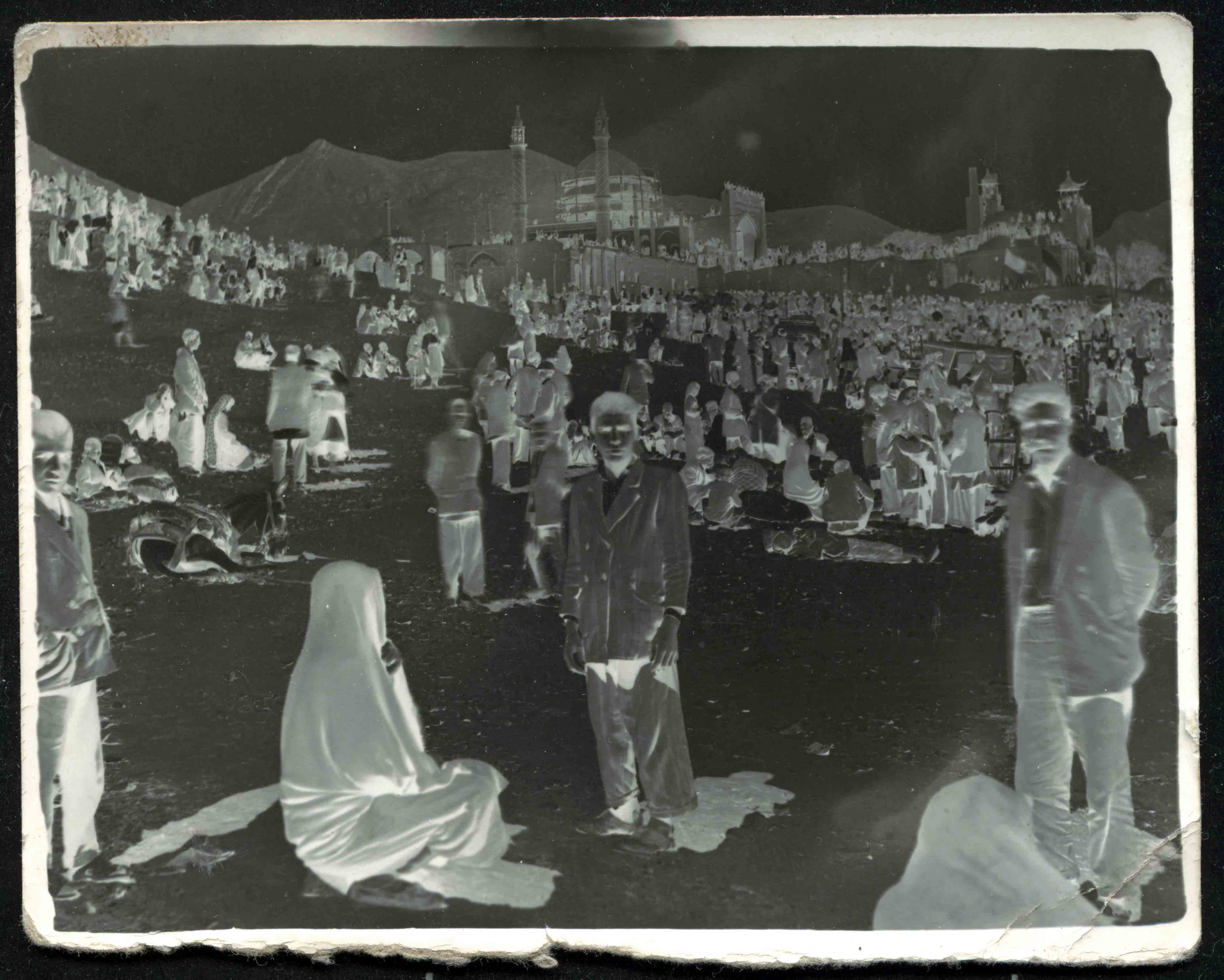
That was years ago. I don’t remember exactly how many—maybe fifteen, maybe more. I have looked at these photographs often since then, scrutinized them, and I keep them in a shoebox instead of the old plastic bag in an effort to treat them like a proper archive; one in a museum, where visitors could put on white cotton gloves and look at them and touch them—an respectable archive.
I purposefully begin this exposition in these banal conditions. The banality itself is in fact a driving force in making the familiar strange, and the strange familiar; digging into the prosopagnosia of our collective past, the in/visible of our contemporary history. This exposition is simultaneously an attempt to create an archive and to expose it for viewing, placing the images in context, commenting on them, inviting new interlocutors, writing marginalia around them, and reclaiming their embodied, itinerant life. As Shahram Khosravi wrote in the catalogue exhibition in the first public presentation in Tehran, the images can be seen as overlapping experiences through time and space that turn the photographer into a storyteller, in the Benjaminian sense. [1] In his 1936 essay “The Storyteller: Observations on the Works of Nikolai Leskov,” Walter Benjamin expressed concern about the disappearance of the art of storytelling. Benjamin saw the modern format of stories – the printed novel – as having led to a world devoid of shared, communicable experience; his storyteller integrates the tale into the experiences of the audience. He transforms the listeners’ experience into his own, depersonalizing the story and producing a phenomenon that we can all share, understand and imagine. Perhaps itinerancy departs from here: the moment when an individual story becomes our story to share and collect. The art of itinerant storytelling, then, emerges when the storyteller travels from one place to another – not merely to tell stories from distant lands, but to listen, through the gazes and faces of listeners of his story, and to collect fresh inspiration for the next story to tell. The photographs in this exposition tell stories of otherness. Otherness then, otherness now. Otherness experienced by the photographed subjects in this collection, otherness experienced by other migrant workers in today’s Tehran, particularly Afghan migrants. Otherness here, otherness there.
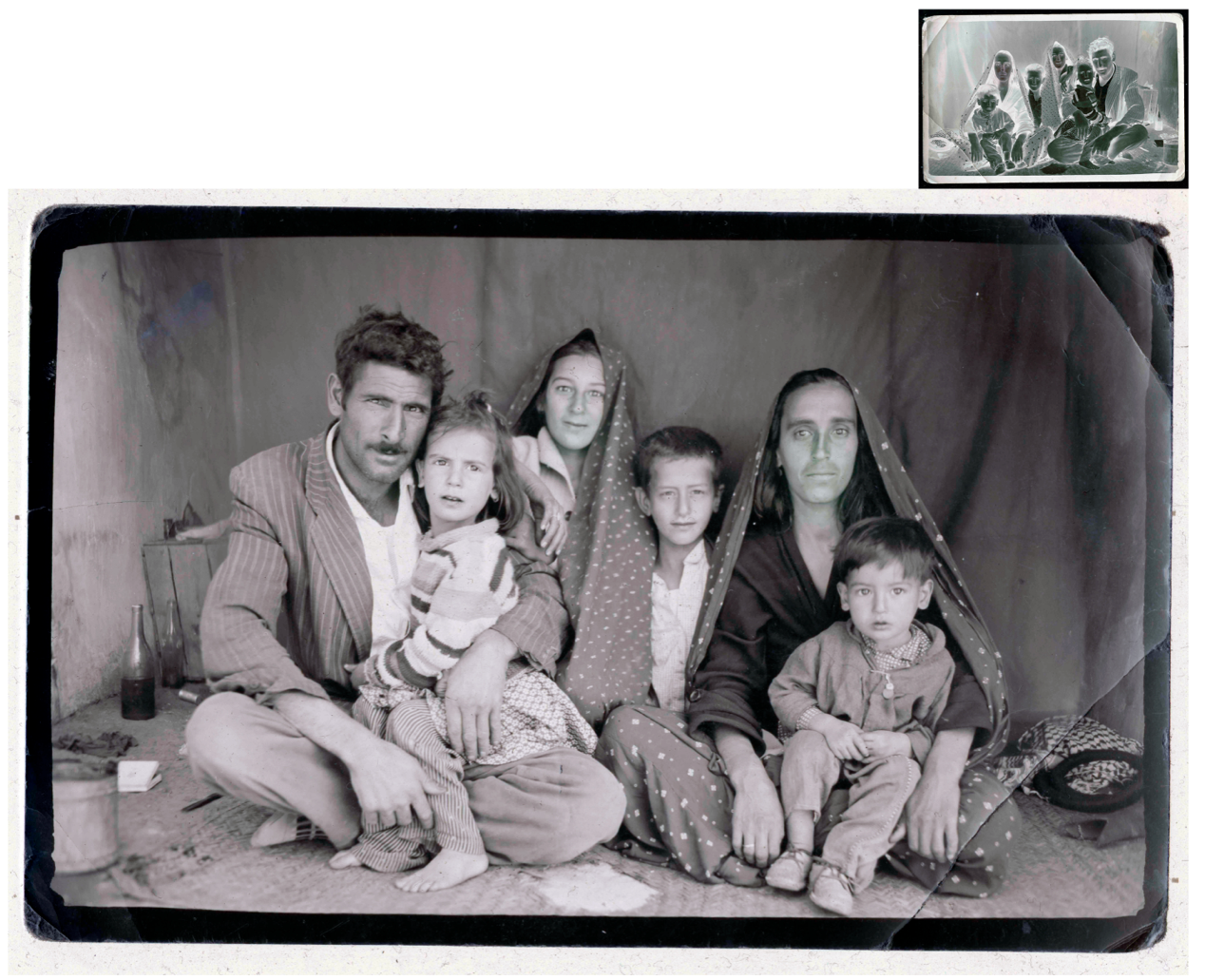
Gholamreza Amirbegi is the storyteller, perhaps unwittingly. He narrates the life of a proletariat who migrated to Tehran from the end of the Second World War until 1956. The majority of the people in these photographs migrated from Meymeh, a small city in the center of the Iranian Plateau, halfway between Kashan and Isfahan. They found a place to live in southwest Tehran, in District 10. Situated near Emamzadeh Hassan, a sacred mausoleum of one of the sons of Imam Hassan (the second imam, according to Shia belief), District 10 is Tehran’s most densely populated district, with four times the population of any other.
Infinite Passion of Life
I recognize some of the faces in the photographs: my mother in a room, acting out a scene from a Hindi film. Not just any Hindi film, but Raj Kapoor’s infamous, four-hour Sangam (1964), which screened in the only cinema in her childhood neighborhood, the Cinema Jay. It was about a love triangle, perhaps a typical imaginary notion of love among the lower working-class in the south of Tehran. It comes as no surprise that almost all the young girls in the archive act out the role of Sangam, the female character in the film, played by Vyjayanthimala Bali. She pretends to be Sangam by poising an index finger on her cheek—a simple gesture, a way to escape the banality of the everyday and transforms for an instant into an admired singer and dancer in front of her father’s camera.
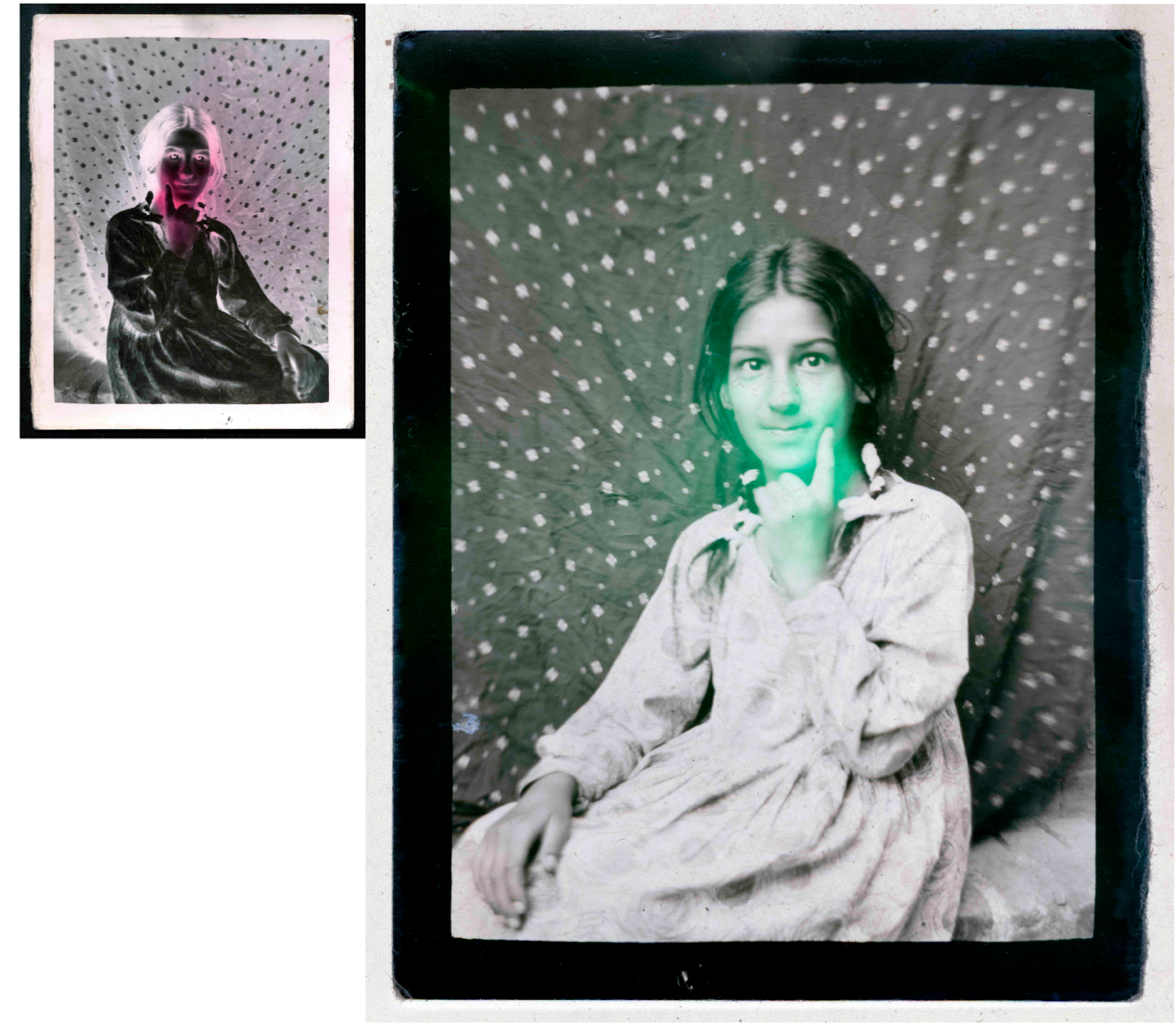
Her face is tinted red in order to balance the light of the photograph—a common technique.
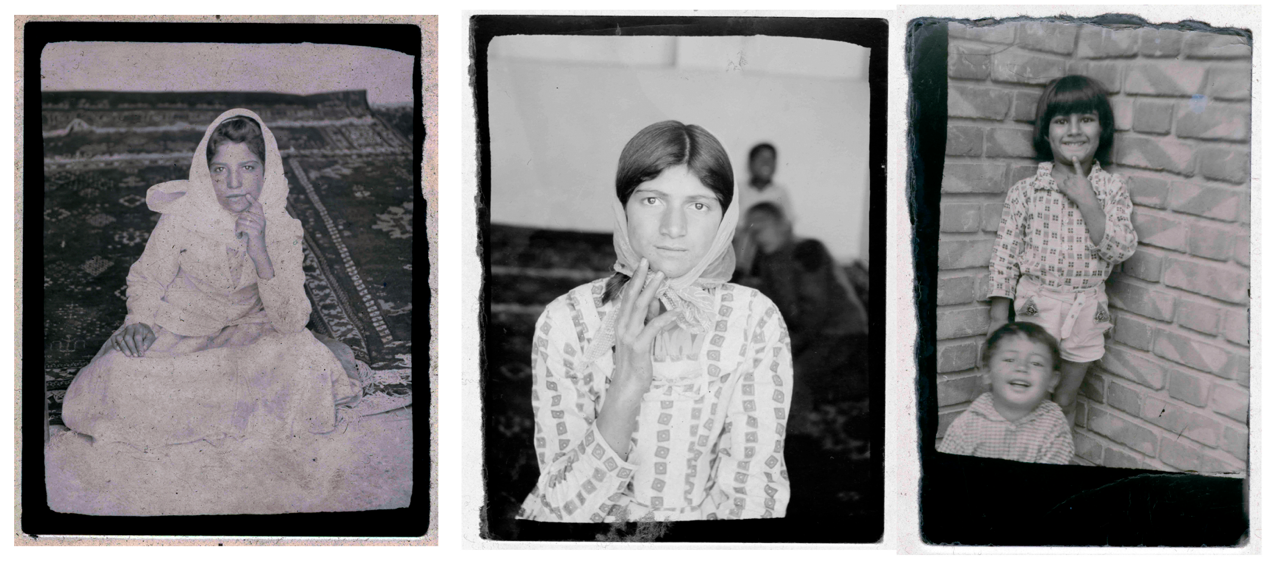
Are these photographs and portraits positioned on the spectrum of fact and fiction as Charlotte Bydler asserts? [2] Curious about the images and the objective behind them, Bydler argues that the intention of the producer is in the ambiguous realm between image-making and artistry and not easy to deduce. She rightfully argues that the context of the art world and its gravity did not exist in the mind of the maker Gholamreza.
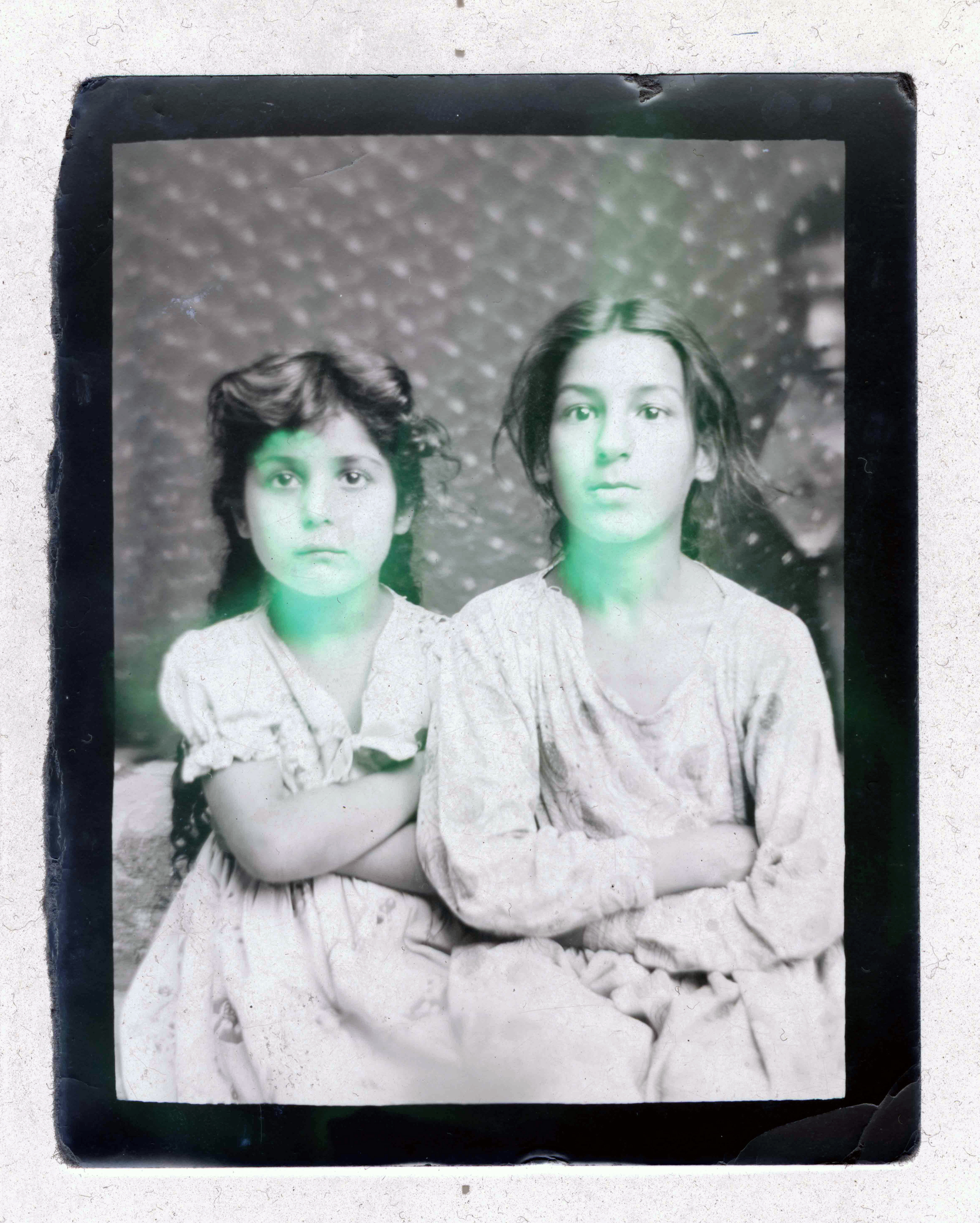
Bydler writes about another of these photos, where a boy looks coyly from the photo and straight at her. [3] He is dressed up in a keffiyeh and framed by an oval-shaped wreath studded with angels and flowers. In fact, the boy smiling playfully is my uncle. The aesthetics of the image reminds her of a Palestinian martyr. One assumes that someone more grown up, possibly my grandfather, has dressed him up like this and framed him in this saccharine-sweet way. He looks far too young to be a revolutionary. Could it be another scene adopted from the global cinema, one where he’s pretending to be an Arab? To my knowledge, however, there were no Arabian films played at the Cinema Jay. Unlike contemporary Arabian music, films from Arab countries during that period (most of which were made in Egypt) didn’t travel to Iran. There was only one movie about Arabia shown at the Cinema Jay: David Lean’s Lawrence of Arabia (1962), produced in the UK by Horizon Pictures and with Peter O’Toole in the leading role. Was my uncle’s costume an attempt to assume the role of the white savior, immersing him in the explorer’s adventures? Or was it just for fun, was he putting on a show in front of the camera for the people who had just left the cinema and wanted to relive their memories of the hero? Or was it simply something my grandfather suggested spontaneously, so that he could permanently imprint his memory of the film onto photo paper? And was the portrait of his son—my uncle—simply a practice round prior to an evening of work, before he left to wait for customers in front of the Cinema Jay?
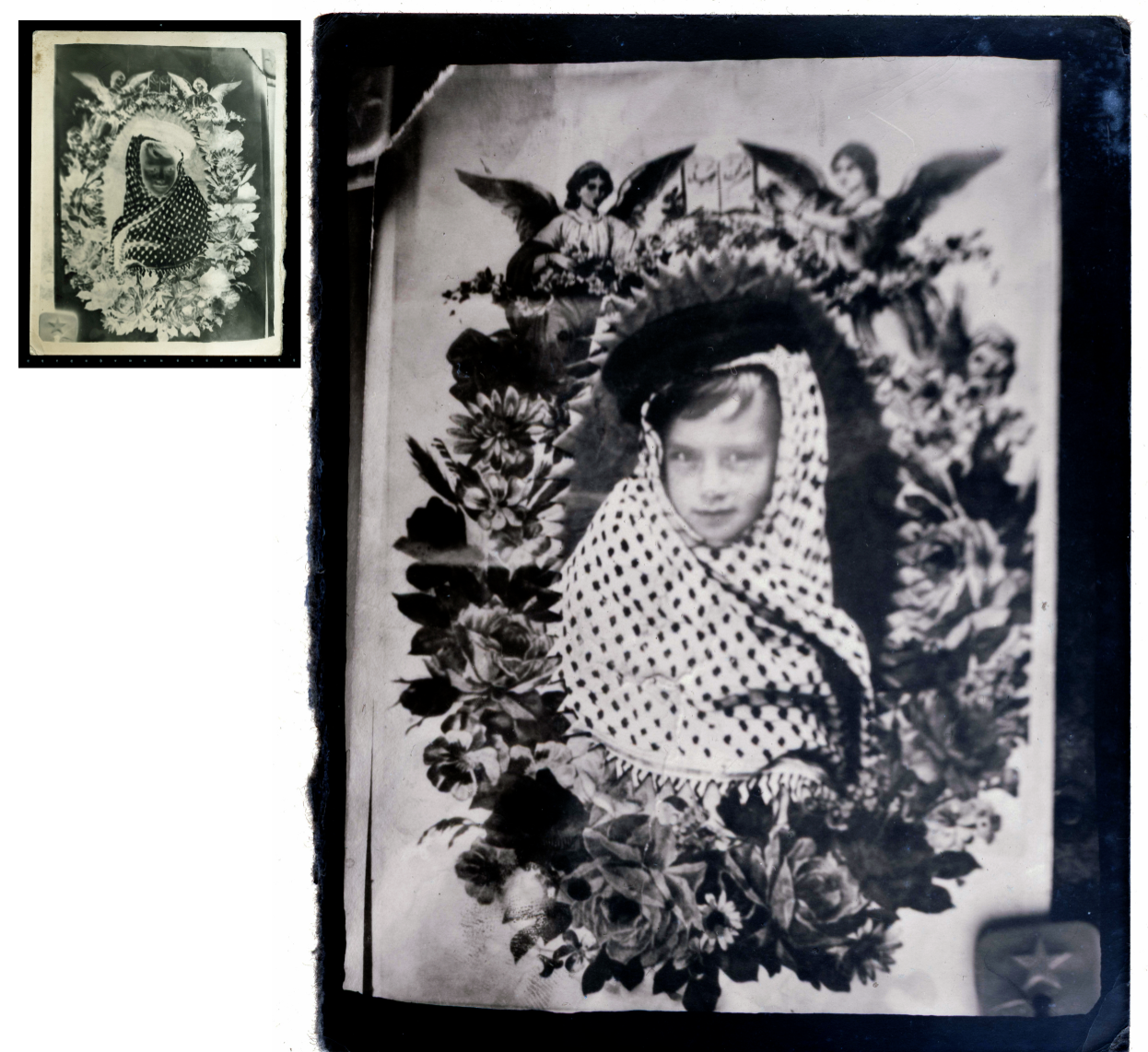
In another scene, a man of indeterminate middle age looks out from the photo seriously. His gaze is directed firmly at the camera and he is looking slightly downward. The man is my grandfather, photographing himself as a test image for the business. He is dressed as a Yugoslav partisan, and he wears a fake uniform. The bandolier slung over his chest and shoulder is an obvious sham, as is the plastic toy gun in his hand. His vest is, in fact, a cheap version of traditional Bakhtiari shepherd’s garb. This is a mysterious picture, full of incongruous details; playful, imaginative and surreptitious. What relationship is there between my grandfather and partisan historical identity? He didn’t define himself in relation to any global resistance. And indeed, when did the Bakhtiari vest become a partisan costume? Or perhaps this was just another scene from a film, shaped by his imagination, in which he roams to somewhere else, becoming someone else. It could have been Yugoslav director Veljko Bulajic’s Battle of Neretva (1969), a WWII drama about the 1943 battle between Axis forces and partisan units that took place near the Neretva River. Perhaps this time he was trying to emulate the actor Yul Brynner.
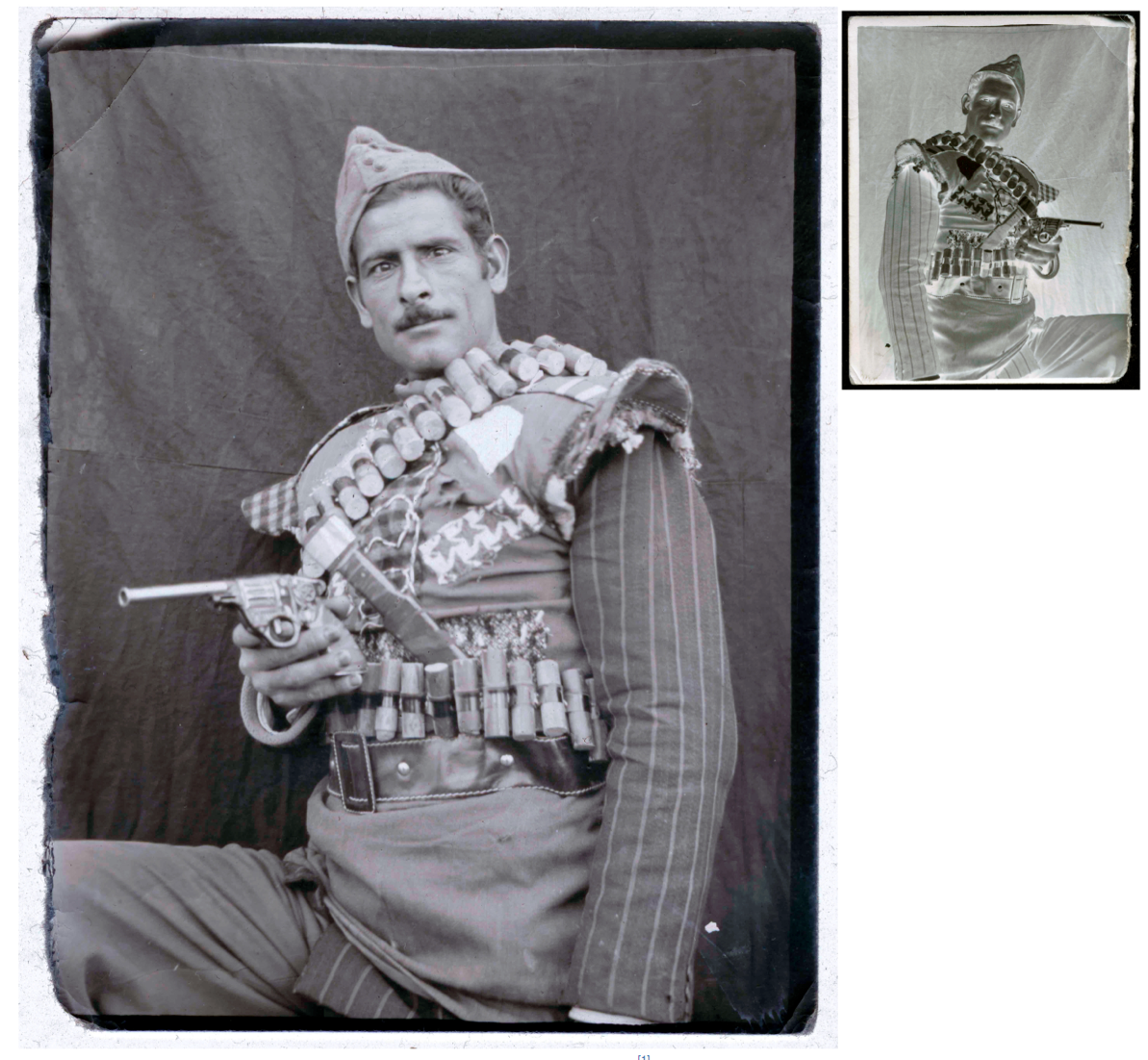
As Federico Fellini said, “There is no end here. There is no beginning. It seems that there is only the infinite passion of life.” [4]
We go through the pictures together and my mother knows most of the places. And, in the darkness of their unrecognizability, she recognizes some of the faces, and some names: Mehri, Jahanbakh, Jahangir, Azam, Rajab, Ghlamhossein, Maliheh, Mahnaz, Grandma…
And many of the locations around the city:
Northern Tehran Emamzadeh Davoud, near our house Teymouri Street, the shopping street Mahnaz, just 10 minutes from our house, Salar Street, our old house was Emamzadeh Hassan, Toupkhaneh (the armory behind City Hall), Bagh e Meli behind Shahrbani, the police headquarters …
An Itinerant Man of Images
Central to Gholamreza’s tiny, peripatetic business were acts of imagination and reenactment—particularly those based on the desire to travel to other places or to inhabit other bodies. There is a fundamental difference here: the imaginative place presents itself not in the subject of the image, but in the backdrop of the painting. Unlike earlier studio portraiture in Iran, where the common backdrops were European-inspired interiors or romantic landscapes, the photographer of these images used Emamzadeh Davoud as a backdrop—a sacred mausoleum in the northwest of Tehran that has become a popular holiday destination among working-class Tehranis, as Shahram Khosravi writes.[5] The storyteller finds freedom in such itinerancy; it is a form of emancipation, allowing him to move to other places and reimagine himself.
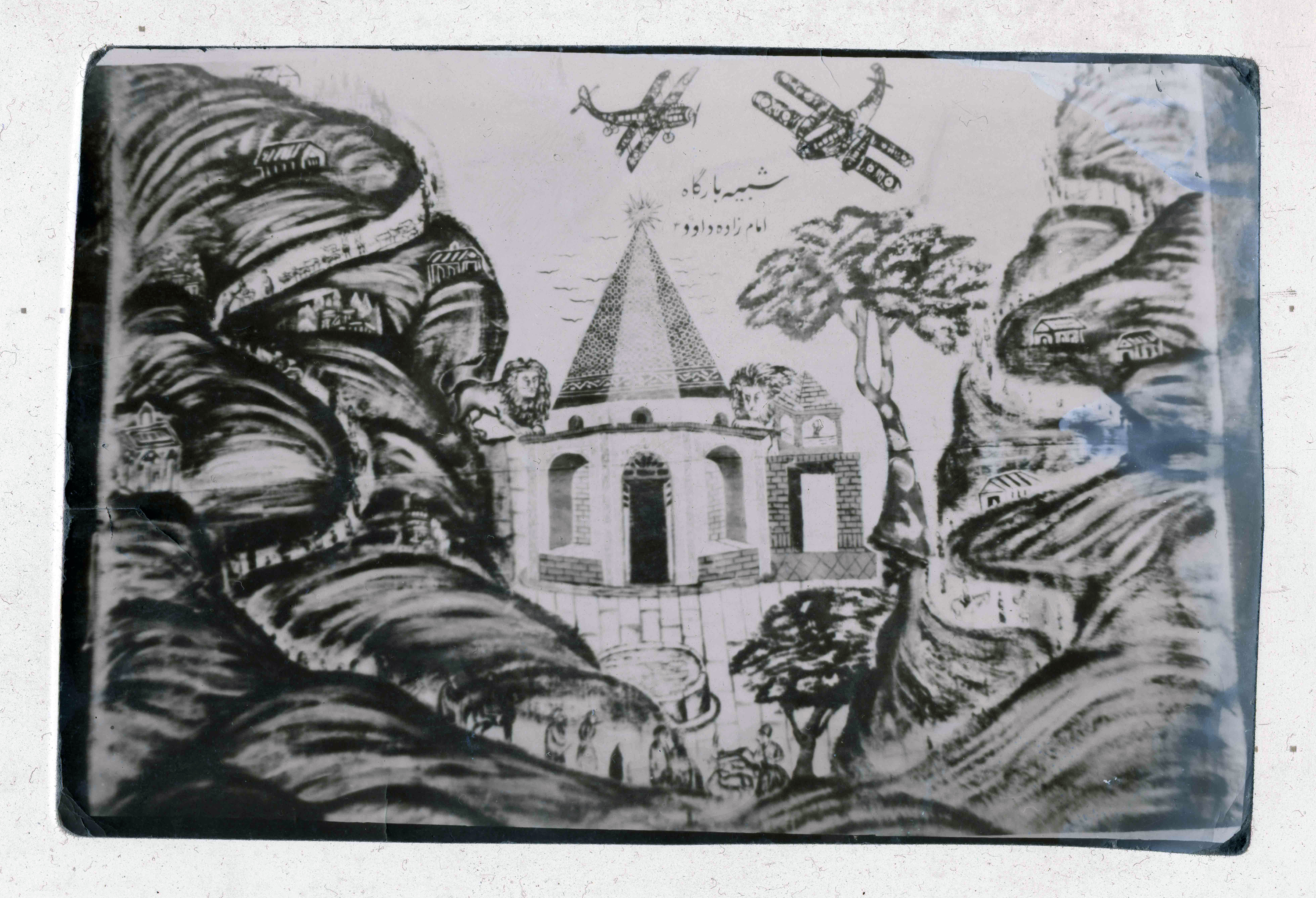
One photo is especially eye-catching: it is taken perhaps in the middle of summer, when the shadows are short and the sunshine beats down on the beach below the street. Gholamreza sits in front of a pinhole camera. He is a young and manly laborer, a smiling peasant wearing a hat and attire that resembles that of a Dervish. Perhaps he has borrowed the costume to test out the concept, which would in fact become his most frequently repeated theme and the foundation of a successful business.

There is a naïve painting discernible in the background: an airplane bearing the name “Iran” (Nastaligh) in Old Persian typography. Its wings have been drawn out of perspective, in a mêlée with reality. The plane is flying above another sacred mausoleum—the Shah Abdol-Azim—in Rey, south of Tehran. This image, too, is an amalgamation of belief and desire, mobility and playfulness.
The mausoleum and the plane are both based on similar desire; they are objects that transport, that lead somewhere else. One transports physically, the other spatially. Yet other elements in Gholamreza’s photographs suggest a desire for mobility and itinerancy through props, either intentionally or unintentionally: airplanes, bicycles, and motorbikes frequently appear in his images for instance, signifying a modern lifestyle characterized by mobility and speed. According to Shahram Khosravi, the use of diverse vehicles is perhaps an unconscious gesture. By framing themselves as mobile, he argues, they not only demonstrate their urbanity, but also their class position. “Indeed, spatial mobility and social mobility are interrelated; they alter one another. [6]. Moreover, the desirability of mobility is notably present in the bricolage of ir/relevant subjects: the airplane, the sacred mausoleum, and the man in the dervish costume.
The photographer could be Rajab, Gholamreza’s brother in law and the one who taught him photography.

Gholamreza was a model for Rajab’s street photography business. Is it the first picture that made Gholamreza a photographer? Perhaps Reza’s faded smile, captured in the moment, is a response to the ironic setting. For Reza didn’t have a coquettish character; as I remember it in fact, he was bitter most of the time, with a perpetually fretful expression on his face. Or maybe it was just wrinkles, the result of years spent in the harsh sun on the streets of Tehran. He walked fast and he smoked cheap, malodorous cigarettes that emitted blue smoke. He could neither read nor write. He knew arithmetic though; addition and subtraction were important for the business. His nails were dark and yellowed from the gelatin silver process used in black-and-white photography. The yellow was actually silver sediment, as he forewent protective gloves. Was this due to masculine ideals associated with being a peasant? Some kind of bravado demanded by male identity, to scoff at safety measures and treat life as harsh and perilous? He smelled of photo emulsion, cigarettes and sweat.

How is it that the figure of the dervish became the subject of his itinerant photography business? And why were the working-class, peasant immigrants of southwest Tehran interested in dressing up as them? There is no filmic source material to be found here. No relation to the Cinema Jay and its spectacular movies. The common genealogy of multiplicity from reenactment in relation to movies doesn’t apply here. There is no Sangam or Lawrence. No love drama, no partisan fight.
An Unconscious Colonial Memory
To articulate what is past does not mean to recognize “how it really was.” It means to take control of a memory, as it flashes in a moment of danger.
— Walter Benjamin, Theses on the Philosophy of History, 1940
Dervish and dervishi have a long history in the Middle East, North Africa and the Ottoman Empire, serving as an iconography of emancipation and salvation from the substantive challenges of the material world. The dervish attempts to liberate himself into the spiritual realm. Running through the city with his Sufi bowl, the kashkool (literally, “to carry on the shoulder”), he sings the song of truth, orienting people in their lives and enlightening them about abomination, hate and obscenity. He is, in fact, a man of truth: a cognitive laborer.
The stereotypical dervish is an old man who lives the life of an itinerant, begging for food in the street. He breathes in another world. He is a Sufi; Muslim ascetic following a particular tariqa—a concept for the mystical teaching and spiritual practices of such an order with the aim of seeking Haqiqa: an ultimate truth. They are known for their tremendous poverty and austerity. Their focus is on the comprehensive values of love and provision, deserting the illusions of ego to reach God.
The term dervish is the most common word to designate the Muslim mystic or Sufi in the Orient, and it appeared for the first time in 1481 as dermschler / durmishlar.[7] in the book dedicated to the Ottoman Empire by the traveler Georges of Hungary. According to Thierry Zarcone in his article about representation of dervishes in the West, [8], the word has a Persian derivation (drigu, driyosh, daryosh), and in the Zoroastrian culture before the emergence of Islam, it refers both to a poor and impoverished man and to a man searching for moral comprehension. The original meaning of this term was not lost with the collapse of Zoroastrianism, but its meaning grew more ascetic and mystical.[9]
Thierry Zarcone traces the history of representation of the dervish from the European perspective to the second half of the sixteenth century, when they were pictured in travelogues about the Ottoman Empire. .[10] In Europe, the figure of the dervish is exemplary of the Muslim Orient, and it is repeatedly pondered as an embodiment not only of mysticism but also of religious extremism or oriental despotism. The word appears in literature—for instance in the writing of renowned French authors like Molière, Montesquieu, Voltaire and Victor Hugo—as well as in paintings, drawings, photography and postcards.
The orientalist fever at the turn of the nineteenth century and “orient tours” in 1820-1830, brought new attention to the dervish in new-fangled aesthetic realms.[11]. According to Zarcone, there is a paradoxical combination between beauty and fear. Portrayals of the dervish embodied not only their latent beauty, but also a sense of dread.[12]. Their mystical identity signifies the explicit pleasure taken in the other. Victor Hugo, having never visited the Orient, gave the title “Darvishe” to a chapter in his 1829 Les Orientales.[13]
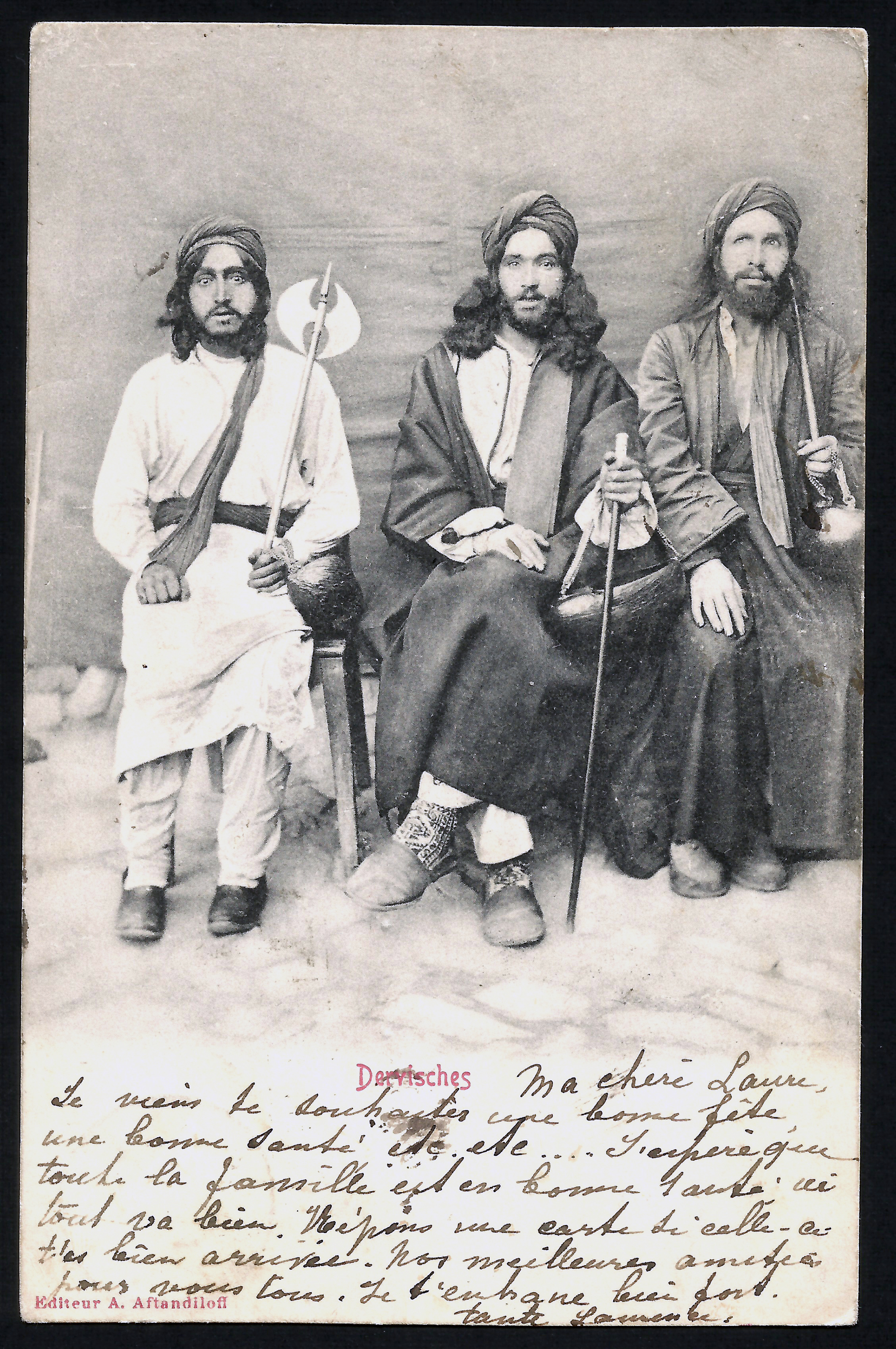
In nineteenth-century iconography, the dervish served as a virtuous example of a figure who bore all the aspects of the other in the eyes of the Western traveler: frail, fragile, and eccentric, sitting low in a narrow alleyway at the edge of the bazaar in the crowded part of the city. His whirling and howling represent the antagonism of the materiality of history. He was visible in the banality of everyday life, and hence easy to capture. At the same time, in the eyes of the Western tourist, he was spectacular and desirable. European travelers drew, painted, and photographed the dervish.
From the perspective of the Western orientalist photographer, the dervish has been presented and perceived as a pure other, representing another mode of existence. The appearance of dervishes, however, represents a different world entirely, although it is related to nineteenth-century European romanticism, if unconsciously. Desperation, poverty, a gaunt body, a haggard face, and a deep gaze create an association between orientalism, othering, and nineteenth-century romantic paintings of ruins; the inadvertently simultaneous, and hence inconsistent, relationship between othering and entanglement.
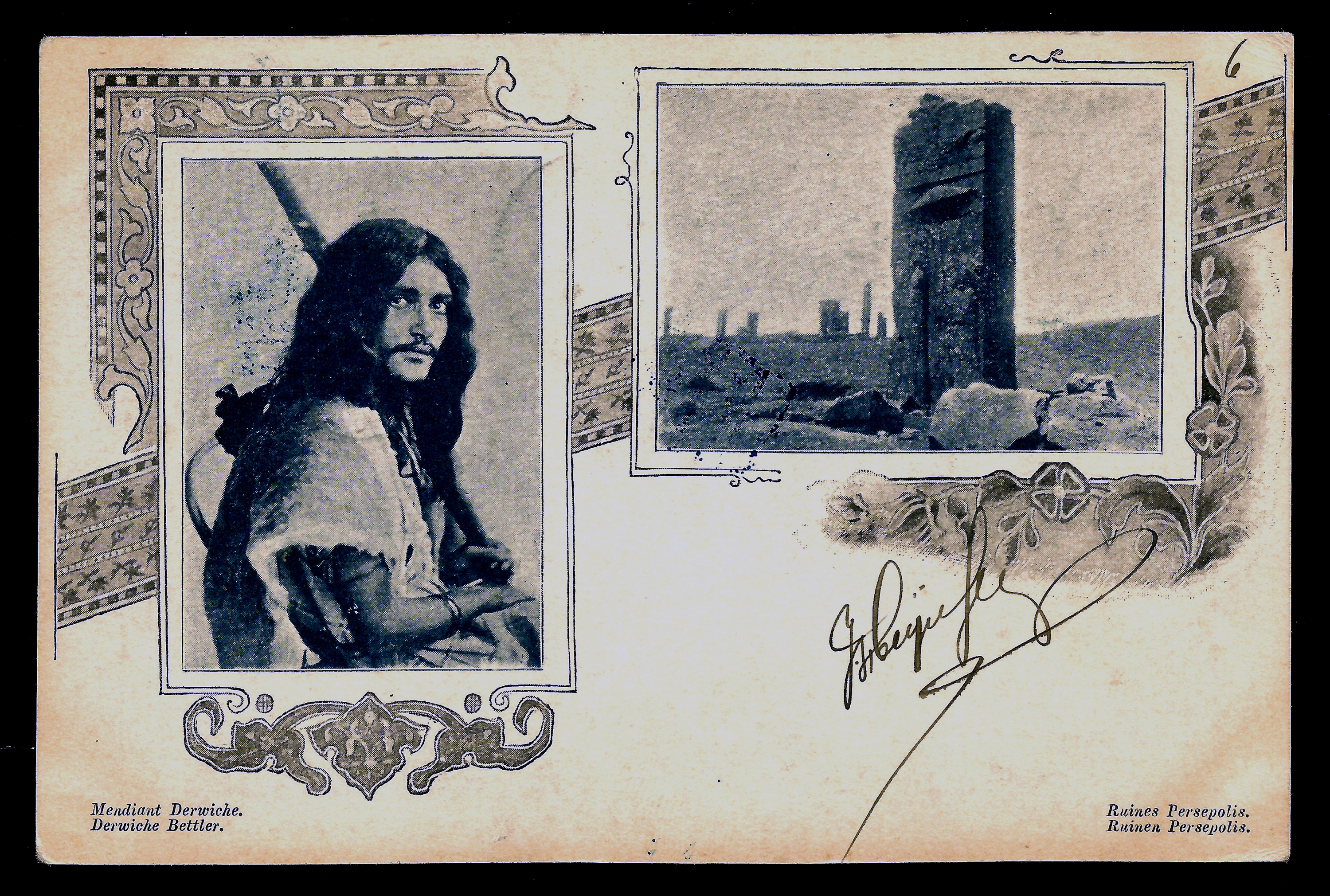
The notion of identity, of “them and us,” is closely related to a sense of place—a relationship between here and there. But there is no uncontaminated meaning of here and there, as isolated and disconnected territories; rather, one always engages in a discursive relationship of inclusion and exclusion, attraction and repulsion, acceptance and rejection—the fundamentally agonistic relationship between what we call here and there. The representation of the other territories and other people were located within the insignificant relationship between fact and fiction; the desire to discover the phantasy in other lands and claim it as the reality. An exploration of a dream land of the other became a field of visual ethnography, and visual ethnography became documentary. The fictional capacity of documentary proposes new reality.
It should come as no surprise, then, that as they applied the new technology, Western photographers reiterated this historical pattern. What began as historical curiosity eventually became an industry of image reproduction, with one minor distinction: some photographers were more attracted to producing realistic pictures and providing visualization. The new industry of image production demanded a permanent and stable relationship to the place to illustrate the dervishes’ day-to-day lives for travelogues, postcards and for the studies of the first European researchers. And the visual ethnography and phantasmagoria of otherness only became more concerted: by 1840, one enterprising Western photographer opened a studio in Istanbul and later on in Tehran. The new technology spread the European traveler’s interest in both in the West and the East. The metamorphosis of the dervish from a social phenomenon into a photographic subject took place against the backdrop of an East that was emulating the European desire for technological innovation. Indeed, Easterners began to observe the banality of their portrayal from behind the lens of the new technology. Could it be that the process of internalization and subjectification of their own lives arose from here—a juncture at which a colonial body projected a new mode of valuation onto their lives? Or appeared out of hospitality, an effort to accommodate the guest’s desire and need and act as they wish? Or perhaps it was a mixture of fascination with their technology and hospitality.
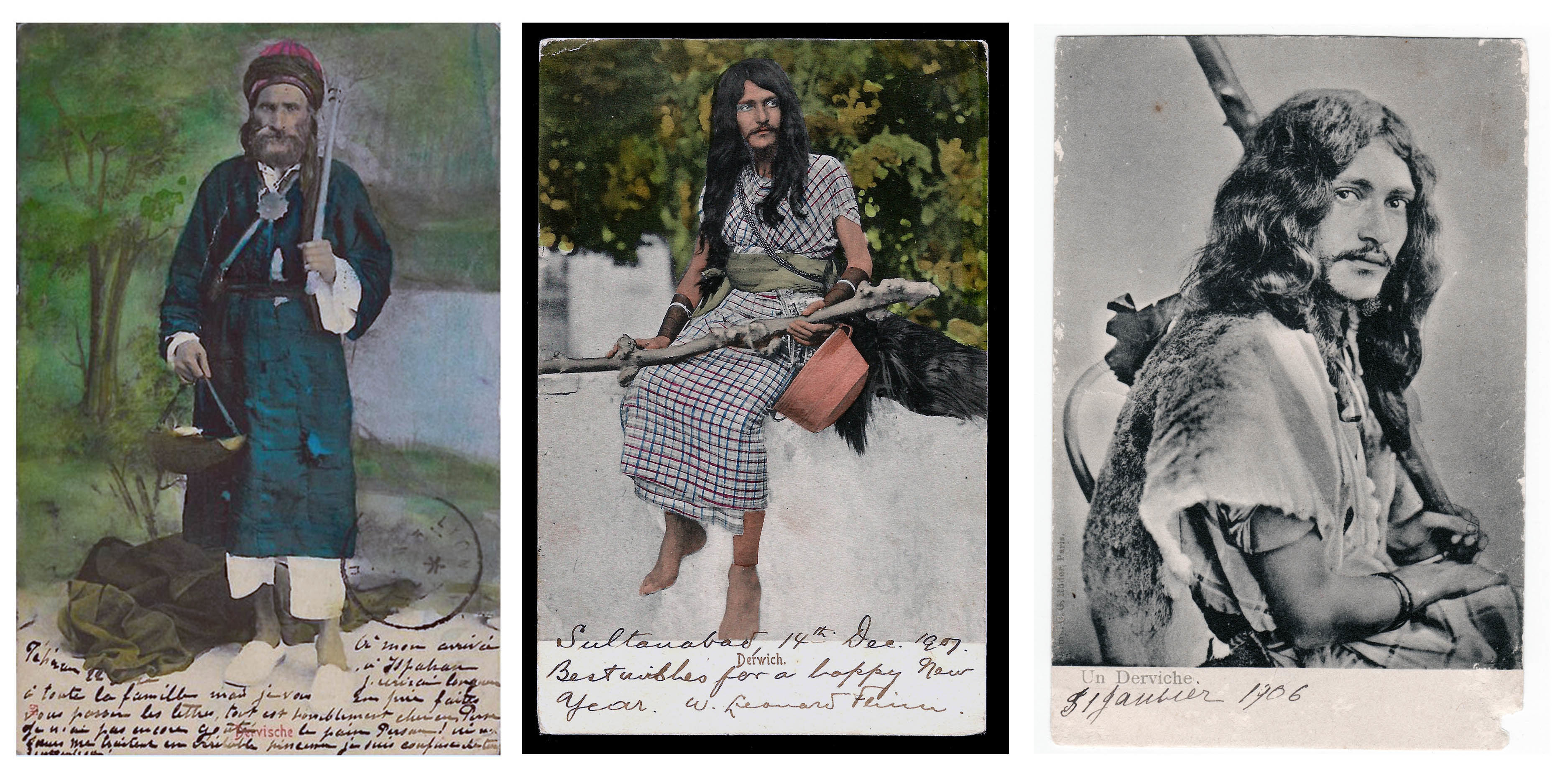
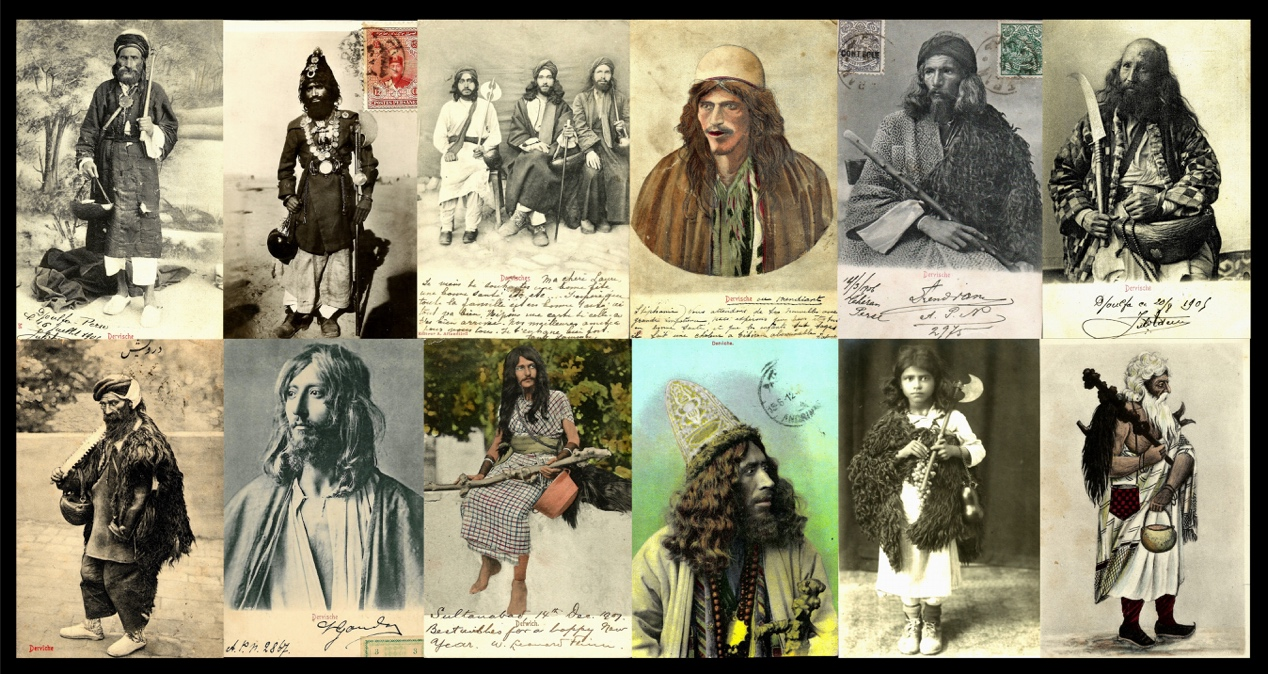
European readers, who had read about and seen a great deal of images of dervishes in magazines, paintings, pictures and photographs, eventually sought to bring them to the west. And so, in 1899, an event was organized in Paris to coincide with the zoological and ethnographical exhibition at the Jardin Zoologique d’Acclimatation.[14] In the heyday of French colonialism, Parisians’ curiosity was piqued by the customs and lifestyles of foreign peoples; indeed, they exhibited “primitive” tribes in a human zoo. Among them was a group of around twenty Sufis in a pavilion called the “Théâtre des derviches” (Theater of the dervishes).
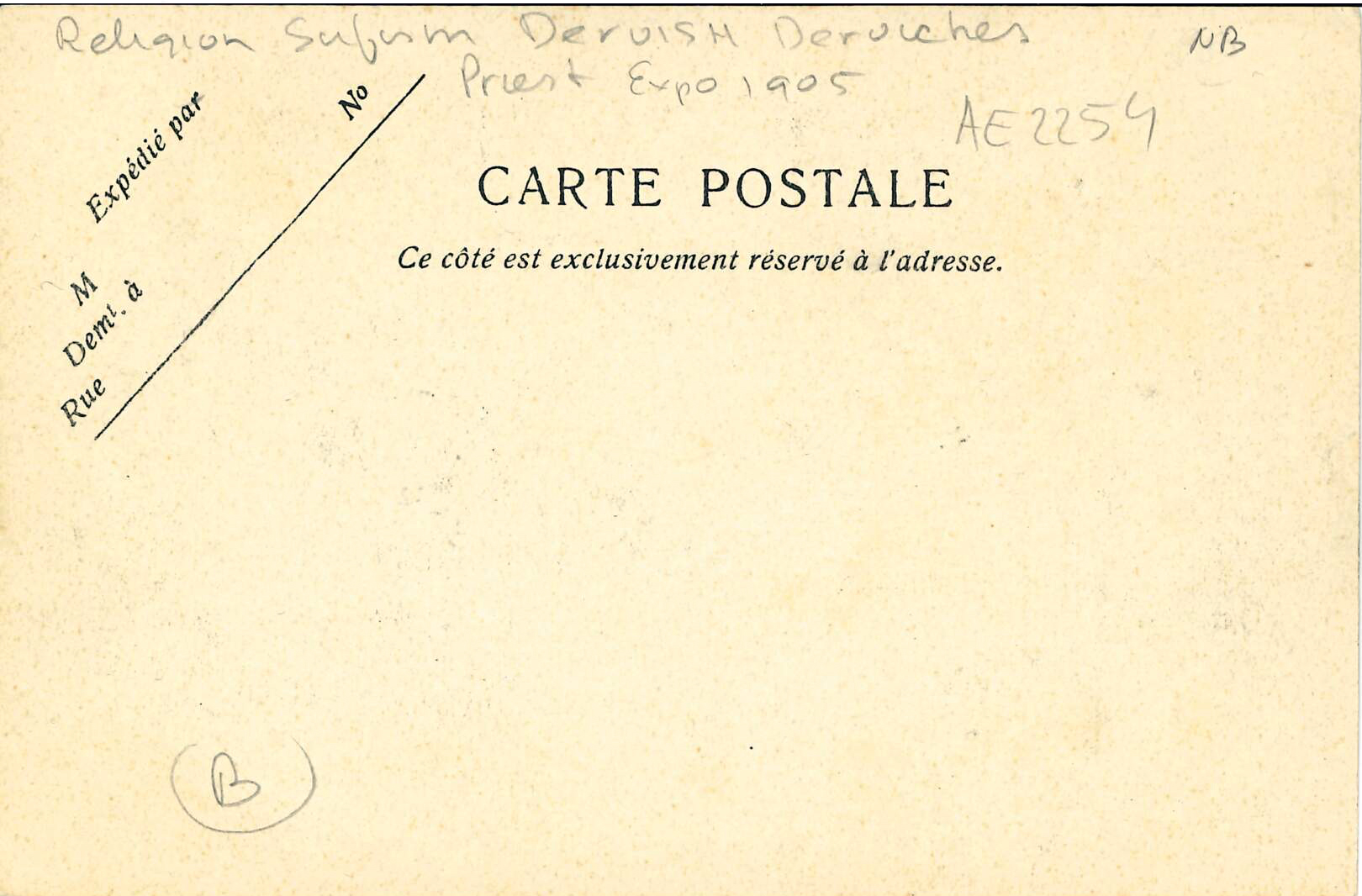
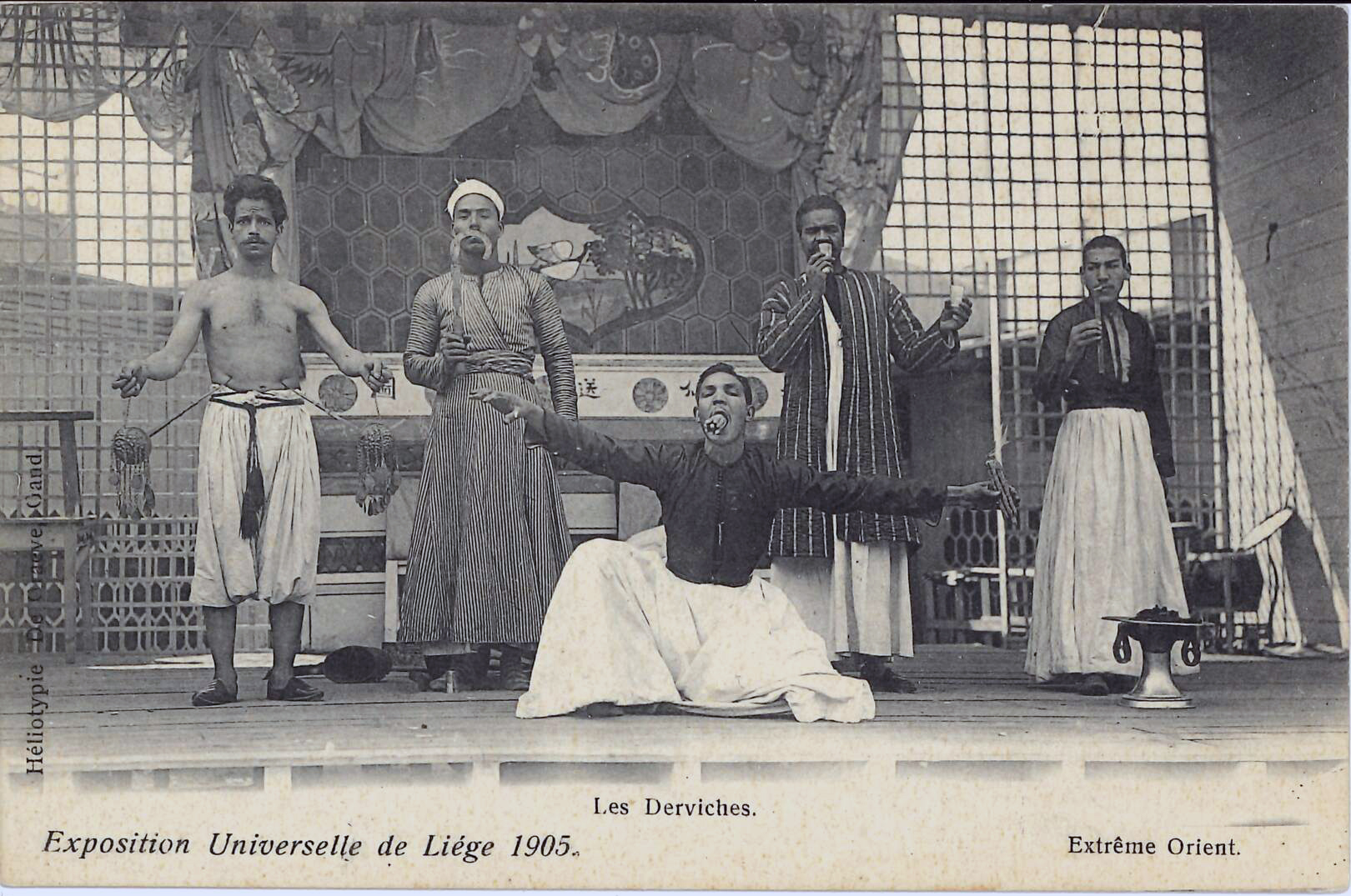
The representation of the dervish as a desirable subject continued in the beginning of 20th century. A large number of postcards were produced, mainly in Persia, and sent to Europe, where they would be sold.
Numbers of photographers were involved in this process of image production. Some notable names such as: Charles Harvey Stileman was an Anglican clergyman, who became the first Anglican bishop of Persia from 1912 until 1917. German Ernest Hoeltzer was one of the pioneering photographers during the Qajar period, even working for Naser al-Din Shah Qajar for close to 20 years, until his death in 1911. W. Orden; Dmitri Ivanovich Ermakov from Tiflis, Georgia; Joseph Papazian, a royal court photographer of Armenian origin during the Qajar period from 1870s. Papazian was one of the first photographers to open a photography studio in Tehran in 1875. and most notable photographer Antoin Sevruguin.
The Poetics of Politics
As Tehran modernized and forged a new urban identity, the presence of the dervish gradually faded. His tiny body and tattered clothes became icons of premodernity; in effect, the old other began to be replaced by new others. Society began to distance itself from “barbarism” via the claim to modernity, reproducing the history of orientalism as a means to purify itself from a “ferocious” past; to become modern was thus to see oneself through the Western gaze.
These processes of modernization demanded a new sort of document: one with the bearer’s photograph. As an essential part of applications for personal documents, portrait photography comprised the main source of revenue for the new business in Tehran. Situated close to the city’s administrative offices, the business provided photos for passports, driver’s licenses, and military service certificates. The 4x6 black-and-white pictures kept the business alive.
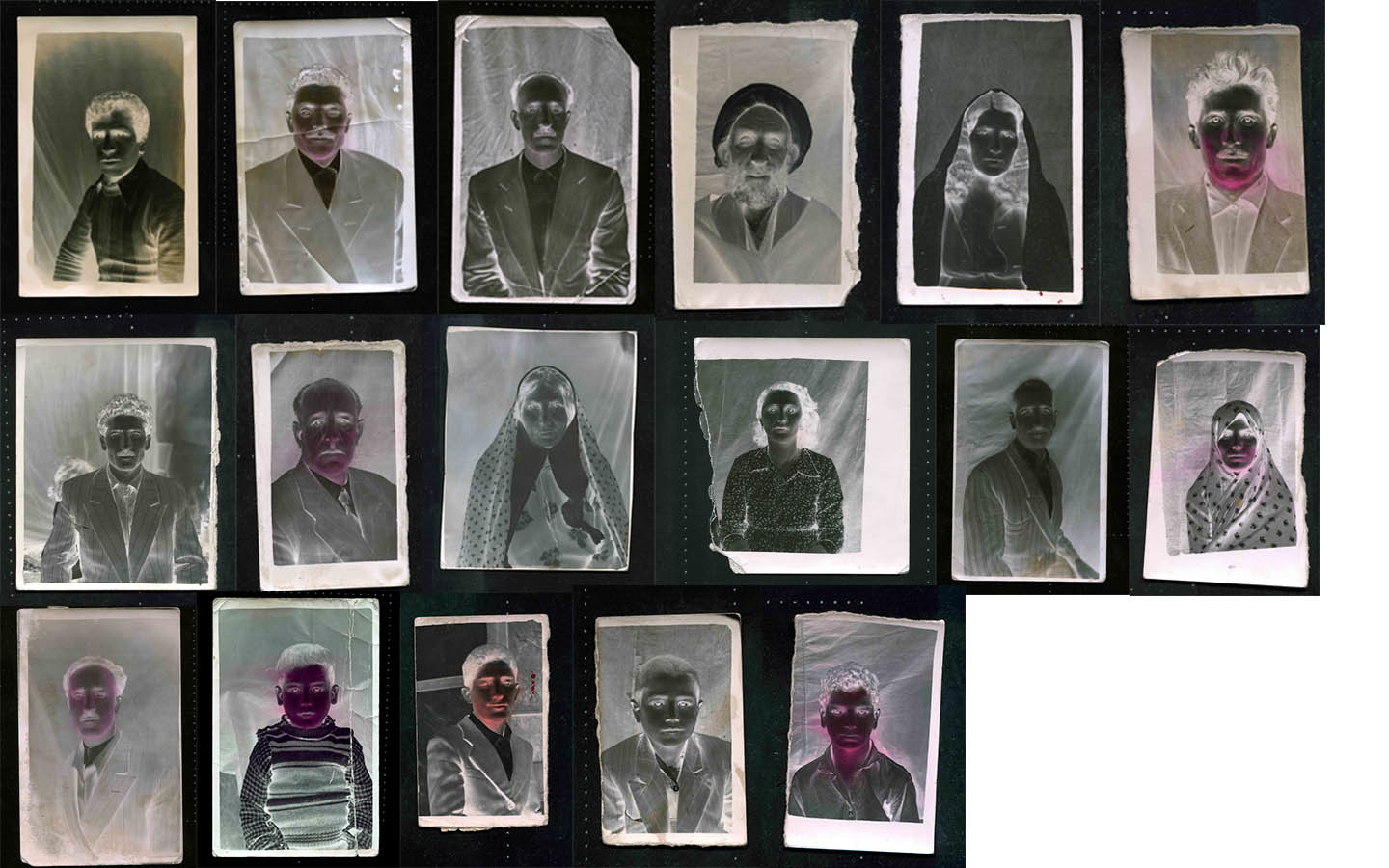
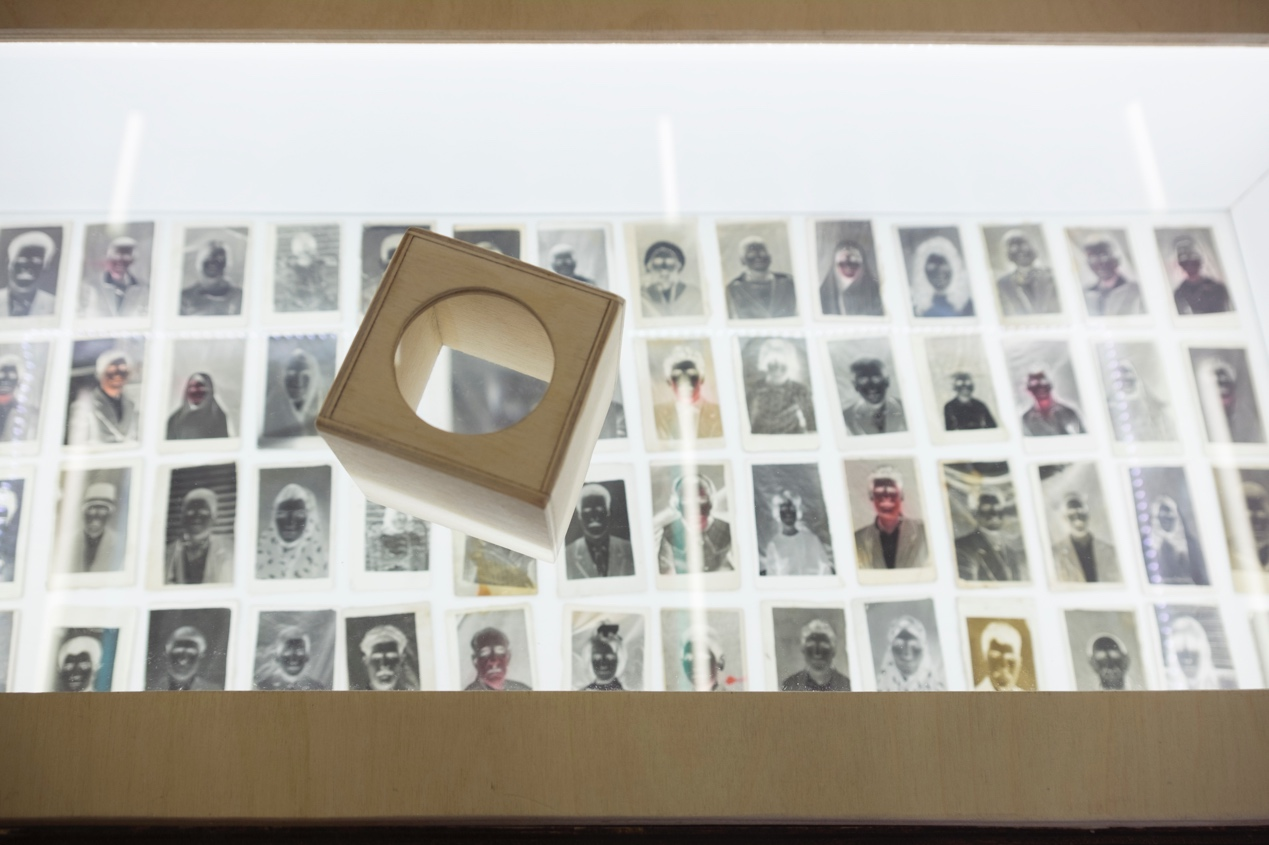
Neither Reza nor Rajab were versed in or knowledgeable about the history of photography, orientalism, or post-colonialism. Neither could read—so what was the source of this repetition and reproduction of colonial memory? A man from a small village halfway between Kashan and Isfahan, in the center of the Iranian Plateau. A family of peasants who had no option but to immigrate to Tehran after the Second World War. They had left home because of drought, famine, and poverty and ended up on the fringes of Tehran as migrant workers—a docile, cheap, flexible, and disposable labor force on which the emerging middle-class Tehrani lifestyle would come to depend. Gholamreza and his brothers were among the unlanded peasantry, subalterns who lived from day to day without any modern urban expertise. Shahram Khosravi writes about the social agency and stigmatization in the newly invented modern city based on Tehran-centric national culture: the people in the photographs are shahrestani—literally, from the provinces.
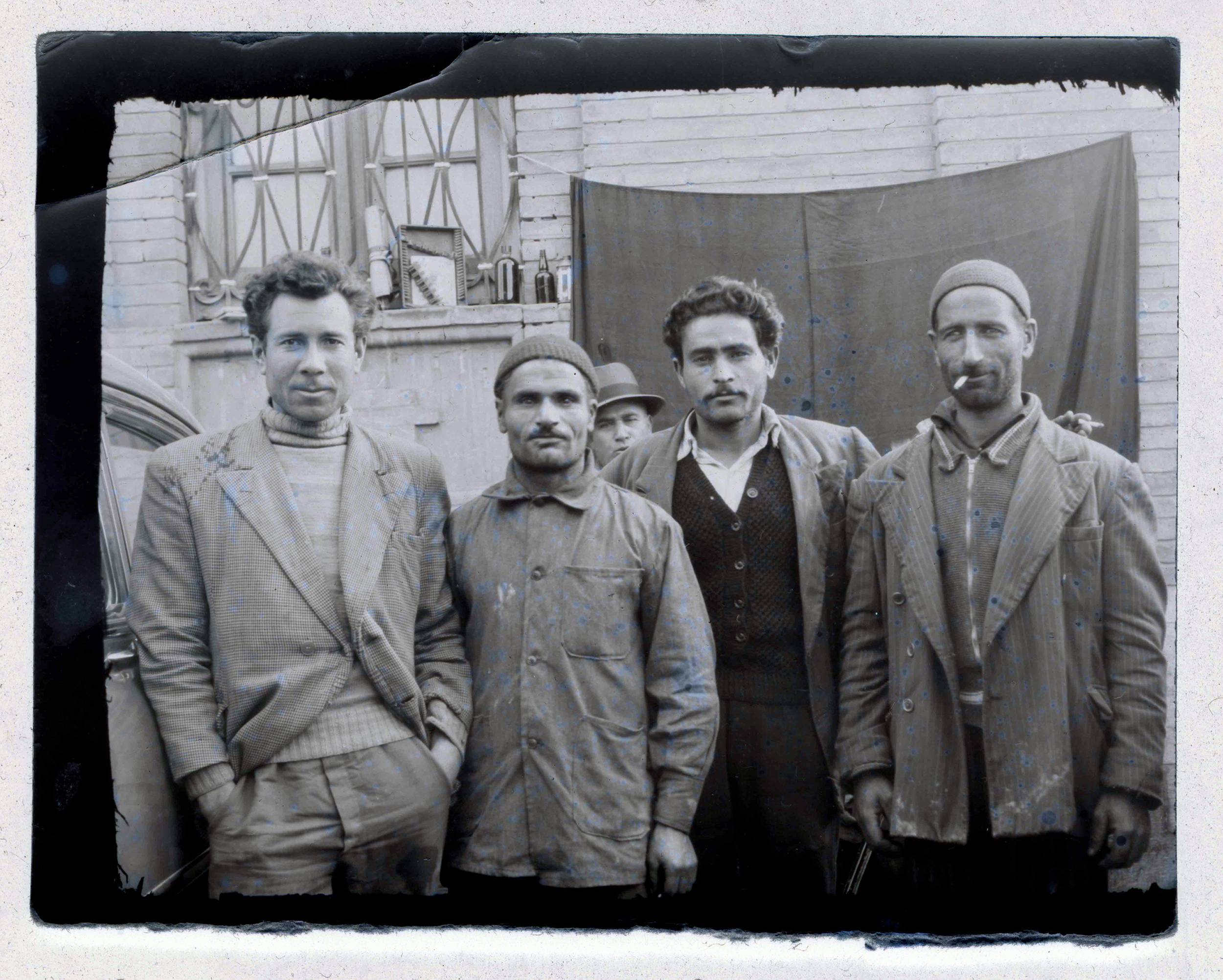
The term, he explains, is not merely a simple noun, innocently denoting a sociologically defined group of people. Rather, it is a term of othering, heavily laden with bigotry, stigmatization, and marginalization. [15] Khosravi also elucidates another patronizing term for a non-Tehrani: dehati—villager—used to designate a person as deprived and uncultivated. The stigma of dehati status is palpable. Labor migration from the rural areas to the cities has rendered the term dehati synonymous with unskilled laborer. Dehati were considered to violate both ethical and aesthetic norms, and their likeness was offensive to the bourgeois gaze.
Historically, official representations of the city have relied on an active unseeing of migrant workers. Though visible, they go unrecognized, in what amounts to a conscious act of exclusion and abandonment.
To self-identify as a progressive society, the modern Iranian nation-state needed to construct the primitive domestic other. This self-identification was thus built on a prototypical act of partition: here and there, them and us. It is a classic strategy that requires a scapegoat who is to be condemned and kept at a distance.

Social reproduction of the stigma didn’t stop with the rhetorical classification of migrant workers; it extended to the depiction of them in popular culture. For instance, they were portrayed as foolish and backwards in newspapers and in the Film Farsi. [16] It seemed that history was repeating itself. The same discourses that had formed the initial relationship between East and West (and Eurocentrism) now pitted the center against the margins once again—this time as a mechanism to preserve the hierarchy of the urban labor market.
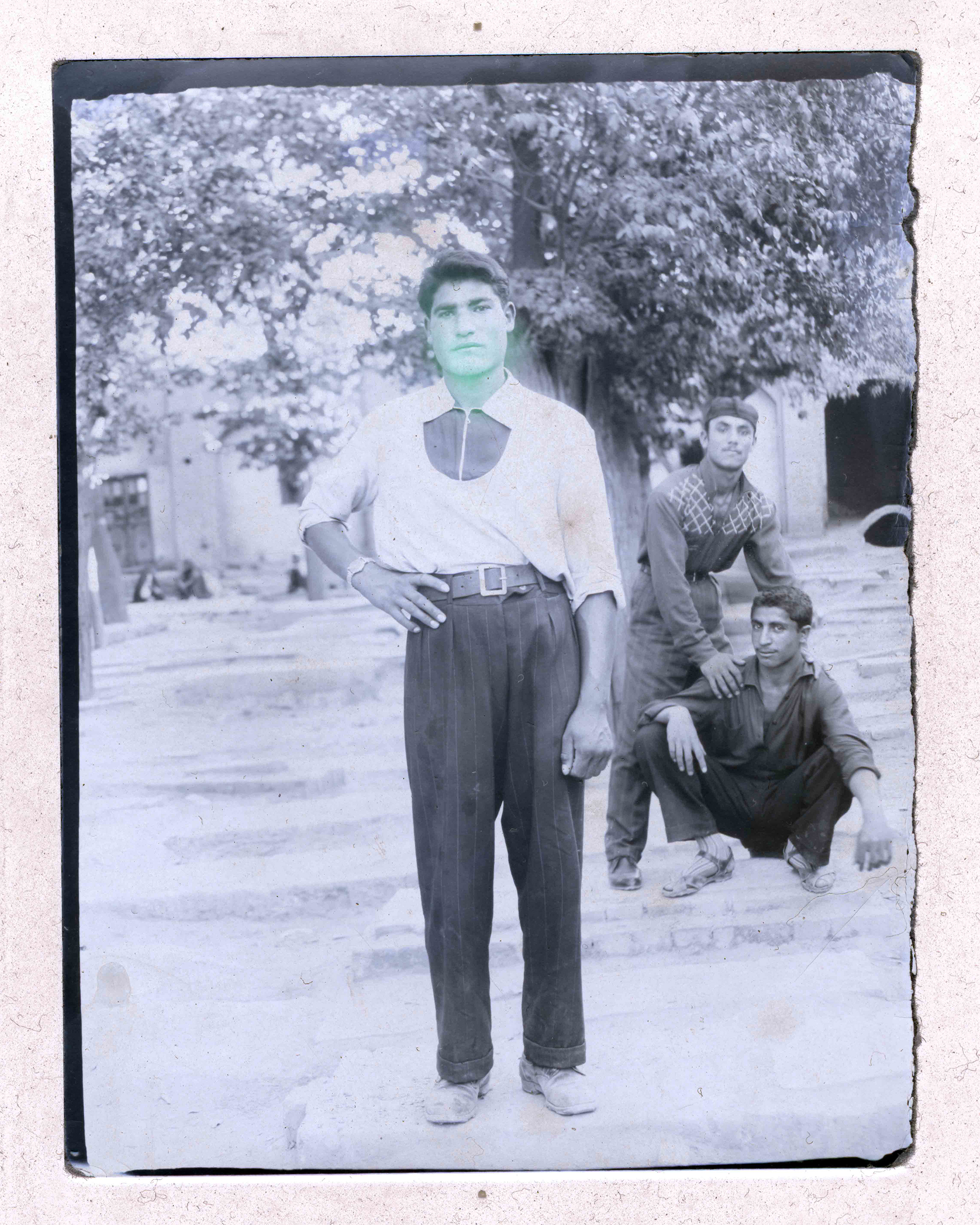
But these images do not serve merely to document an incipient modern society. They are also playful: a form of entertainment that explores what it feels like to be the other; a distraction from the banality of the everyday. Gholamreza’s photographs are a mix of street entertainment and urban memory.
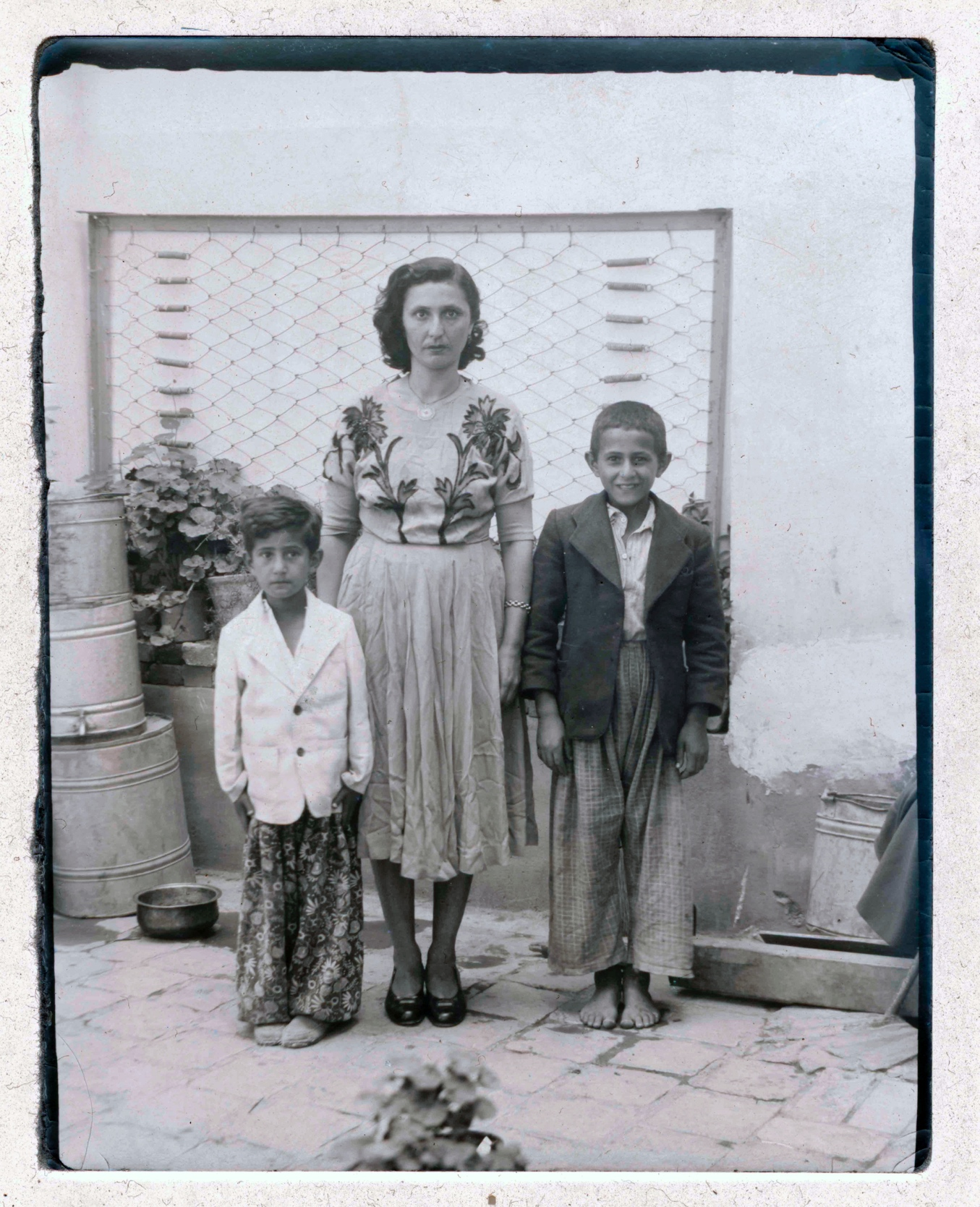
Perhaps they reflect an unconscious desire of the lower-class community to become a dervish, a continuation of down-to-earth, working-class identity. Indeed, donning the costume of the dervish signified a strong desire to represent poverty as an acceptable form of social participation. Poverty and inequality were integral elements of urban identity in southern Tehran.[17] To impersonate a dervish has a different meaning here compared to the colonial history and the relationship between East and West; why would a commoner want to represent himself as a commoner? To feel the urge to become a dervish for a moment in the streets of Tehran, and to preserve this image forever on the silver photography paper suggests an ironic playfulness. It is a performativity that connects the unconsciousness of twentieth-century working poor identity to nineteenth-century colonial memory. Narrative plays an important role in this self-creation and reproduction of identity. It is a signifier, the channel through which he tells himself and others the story of his location in the world.

What Happens to Narration when It Crosses the Border?
In a series of lectures on the importance of place in fiction, twentieth-century novelist Eudora Welty argued that every story would be another story entirely—and unrecognizable as art—if its character and plot were displaced to somewhere else.[18] . It is an act of translation that re-creates another cultural phenomenon in the process of translation. And not only the artistic and fictional character of a story are important; the historical fact of the ethnographical representation of the dervish holds enough fictional capacities: while photography was still in its nascency, and visual ethnography and representation of reality were among its early applications, it would be incorrect to consider the images straightforward documentations of everyday life. They were in fact a manipulation of the spectator, using elusiveness and conversion by photomontages to combine all the aspects of the Orient deemed likely to satisfy the Western gaze. Some postcards, for instance, ascribed different names to the same photograph of a dervish; others mixed the paraphernalia of more than one Sufi order (Kalenderi, Bektachi, and Rifai), portraying all of them as borne by the same person.[19] Some of the people dressed as dervishes in the photos were not even locals, but Western tourists, apparently posing for an exotic souvenir. Hence, Gholamreza’s dervish photos reflect a process of fictionalization of that which is already fiction; they effect the displacement and translation of one fiction into a second context. They are artifacts of a place that lies between the visible and the invisible, the seen and the unseen. The photos serve as a missing link between what is visible and what is intelligible, similarly to the way Jacques Rancière defines the relationship between expected and nonexcepted, the place of imagination.[20] Itinerancy, or even escapism, is an aspiration to change one’s conditions through an act of imagination, to become someone else, still poor, but in a respectable way; to depart permanently for the land of amusement, preserved for eternity on museum walls, or to travel to other faraway lands as a postcard. It is the desire for immortality, not achieved by being oneself, but by adopting an image or narrative that is deemed acceptable in the eyes of beholder.
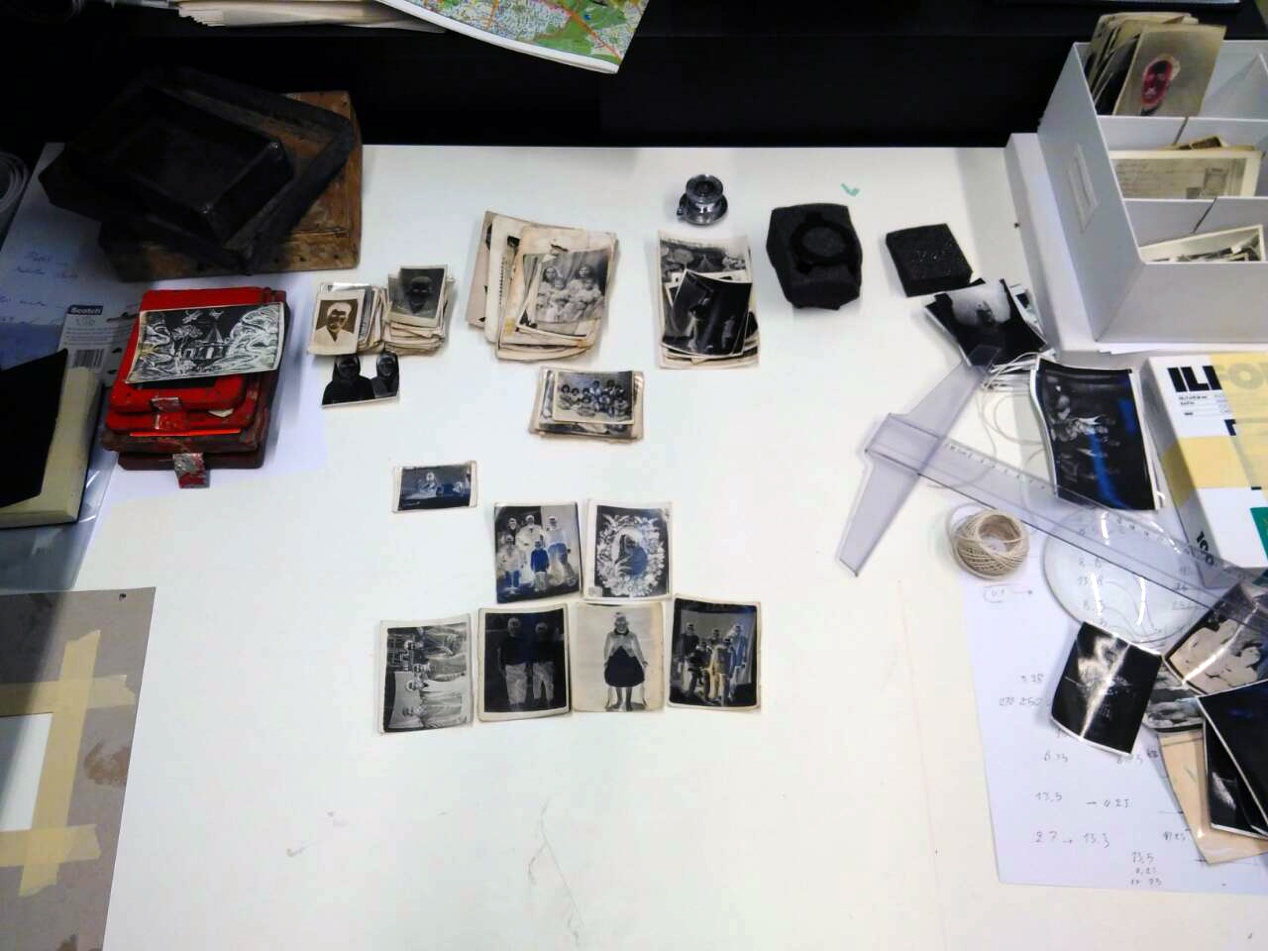
Rooh Kich- Soul Catcher
This is the historical backdrop of the camera used by Rajab and Gholamreza. In the early twentieth century, such devices—essentially a portable wooden hut with a lens—enjoyed widespread use in places like Brazil and Cuba (where they were known as camera minutera) and in Afghanistan (as kamra-e-faoree). [21] Public portrait photography was common. The devices used paper negatives and combined a box camera with a portable darkroom. Some types repurposed the front bellows section of an old camera, which was attached to one end of the processing box; others used an internal focus mechanism, comprised of a view screen and film holder bracket that slid on internal metal rods and could be controlled by a focus rod at the rear of the camera. The operator accessed the camera via a sleeve that fit tightly over the arm. The process required only two chemicals: developer and fixer. From the posing of the subject to the production of a wet print, a typical session might take all of fifteen minutes. [^23]


Commercially available models of this camera emerged in the early twentieth century. Among the first to manufacture them was the Chicago Ferrotype Co., which started making its direct positive “postcard camera” around 1913. A sheet of paper with a blank postcard printed on the back was used, and after exposure the paper was slid into a single chemical bath that would process the completed print; this produced a print without the need for a negative. The technological foundation of this machine was the camera obscura effect observed in earlier pinhole cameras.
It quickly became common practice among aspiring hucksters to buy several cameras and then try to unload them at inflated prices. It seems in fact that Chicago Ferrotype encouraged such pyramid schemes. Traveling portrait photographers were a common sight prior to the Great Depression, wandering from town to town, taking photographs of people and getting paid on the spot: the foundation of itinerant photography.


Chicago Ferrotype Co. went out of business around 1920. No longer able to obtain the cameras themselves or the specialized paper and chemicals directly from the manufacturer, photographers had to get creative. The new generation of itinerant photographers took the bellows and lenses from secondhand cameras and mounted them on boxes, with trays for the requisite chemicals fitted inside.[22] These homemade cameras often doubled as billboards to display the wares, many of them becoming what might be called craft art. Each camera was designed according to personal taste, employing the same structure, but articulating a unique identity. The process of building the camera itself became part of the art of photography. In stark contrast to the notion that the image made with the camera is what constitutes “art,” while the camera itself is merely a tool, these global machines are compelling subjects in and of themselves.
This camera overturned the typical highbrow photography process, especially among the lower classes of the global South, who brought photography out of the studios and bourgeois circles and onto the streets. With these handmade cameras, street photographers disseminated a form of photography that was affordable for the working class—and one that ultimately created its own photographic aesthetics and preferences not only in Iran, but also in Pakistan, India, and Afghanistan.
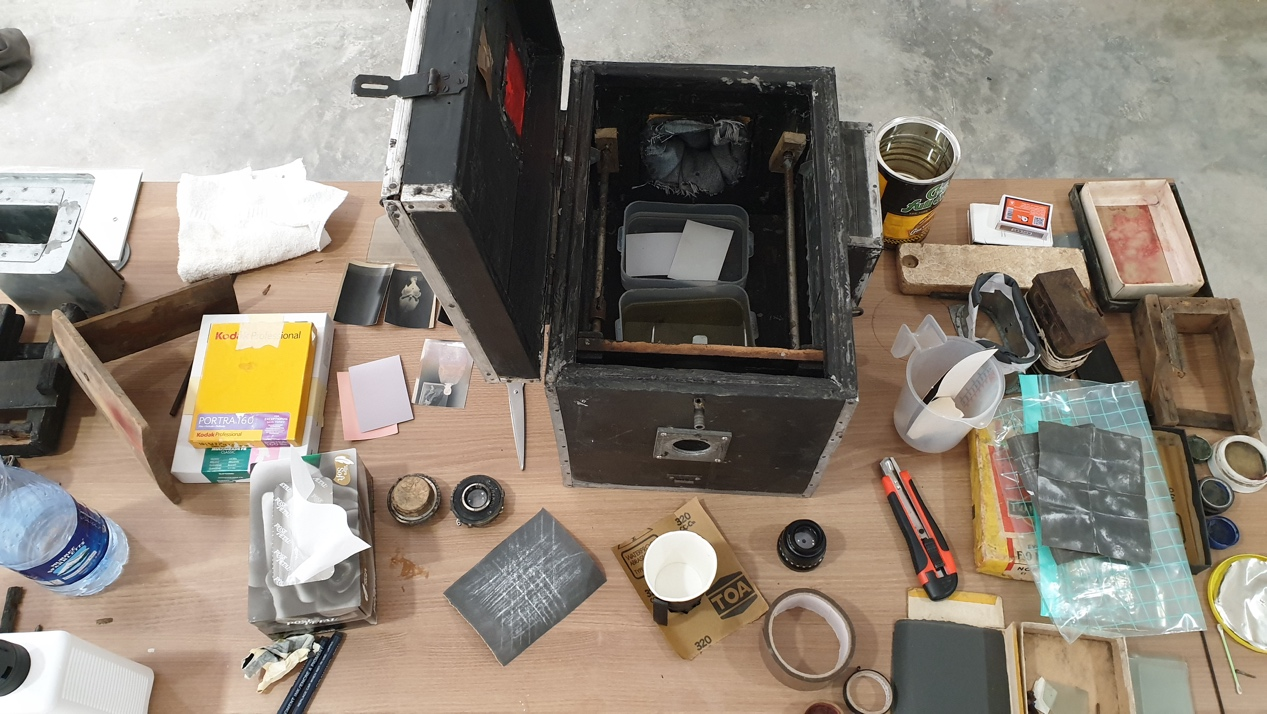
Rajab didn’t know the story of the camera’s arrival in Iran. In fact, the nomenclature he used to describe his camera would have seemed to have little to do with the terms in Chicago Ferrotype’s instructional booklet. Notable among these was his use of the word lopatka to describe the component that held the negative photo in front of the camera.
Lopatka means “shoulder blade” or “small shovel” in a number of Slavic languages. It makes sense; the camera part bears a strong resemblance to one. The use of the word lopatka brings two hypotheses to mind in regard to the origin of the camera, both related to the Second World War:
Perhaps the word was brought to Iran by the Polish refugees who walked 3 000 miles to Persia after the Nazi occupation in 1939.
Migrations such as this one constitutes another important form of itinerancy in our contemporary history.
The paradox of the life of an itinerant is somehow connected to the camera’s Urdu name. On one hand it suggests the phantasm of image, something like a Victorian black theater, a phantasmagoria that projects frightening images such as skeletons, demons, and ghosts onto walls; the enjoyment of being captured by a strange apparatus—and on the other hand the violence of being modern, the forceful idea of transmission from a people to citizen. It is not strange that we use the same terminology for hunting and photography: Loading, capturing, shooting…

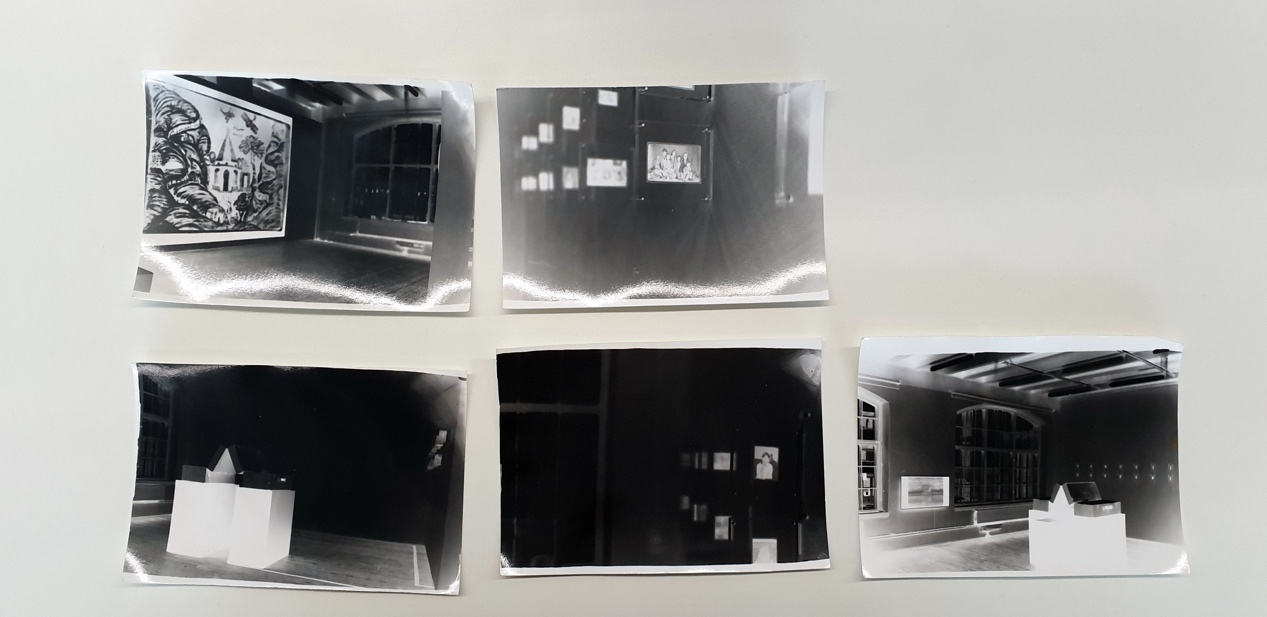
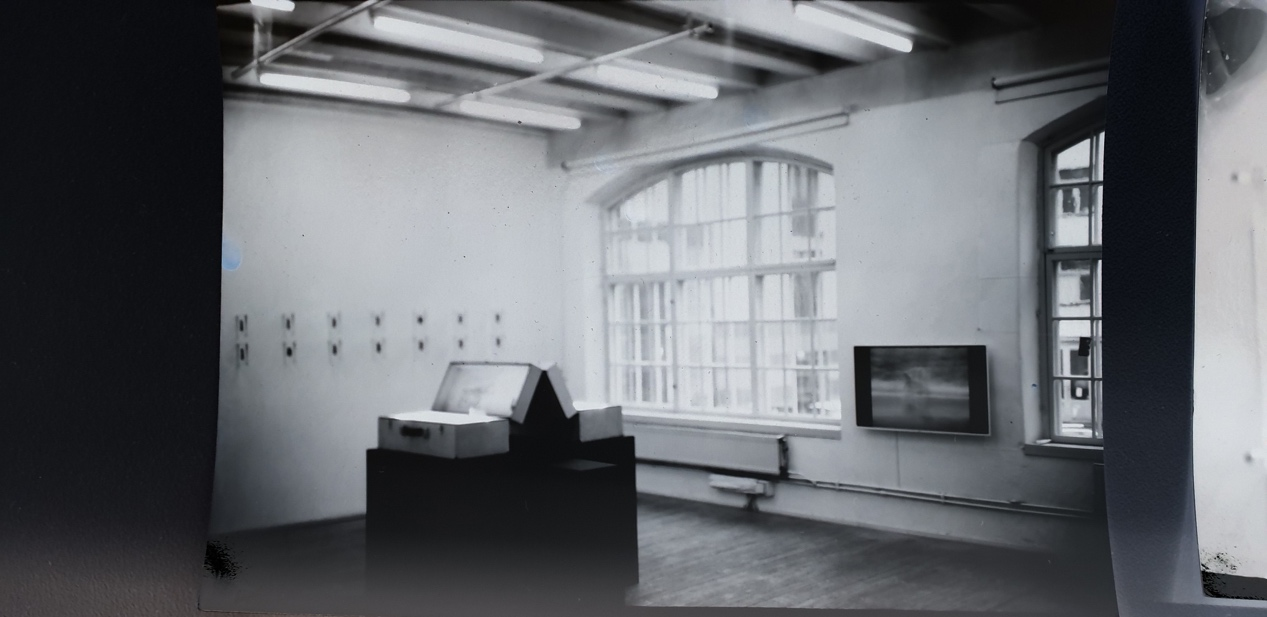
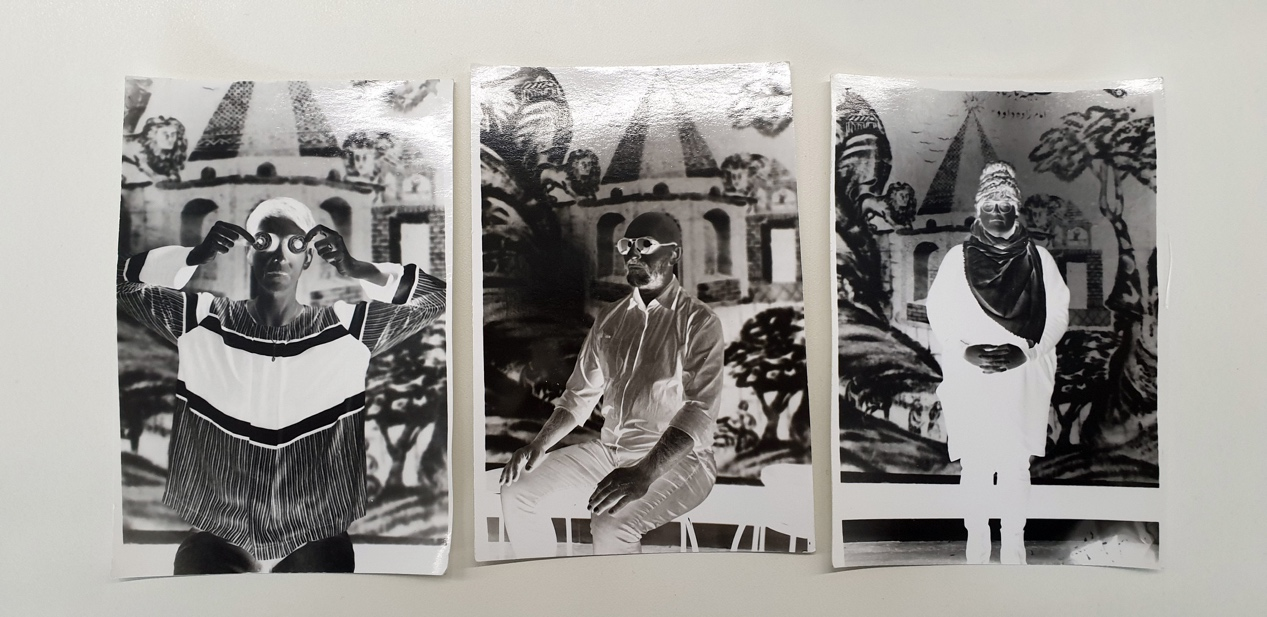
There are historical re-enactments in the exhibition. The act of representation of the materials and simultaneously create a new archive. Can I take a picture of you? I will tell you the story of the camera and this exhibition during the process. Just one condition: pretend to be somebody else. You don’t need to tell me, you could think about a character while I capture your image. Or as in Urdu, catch your soul.
He was right. He surveyed the pattern of history. He knew it from his unconscious colonial memory.
Here I am, writing about him in dervish costume. Showing his image in the global North and historicizing the unconscious relational history from the nineteenth century to the twentieth century and beyond. Somehow, deep down, he knew that if he took a picture, they would archive it. But he needed to find a middleman, in this case his grandson, who has embarked on the journey of class mobility, gained enough cultural capital to claim that Gholamreza was an artist, but he didn’t know it. The picture is in fact his monument, a memorial spatial monument dedicated to an invisible, and now visible, proletariat after almost a century: a monument to the invisible citizen.
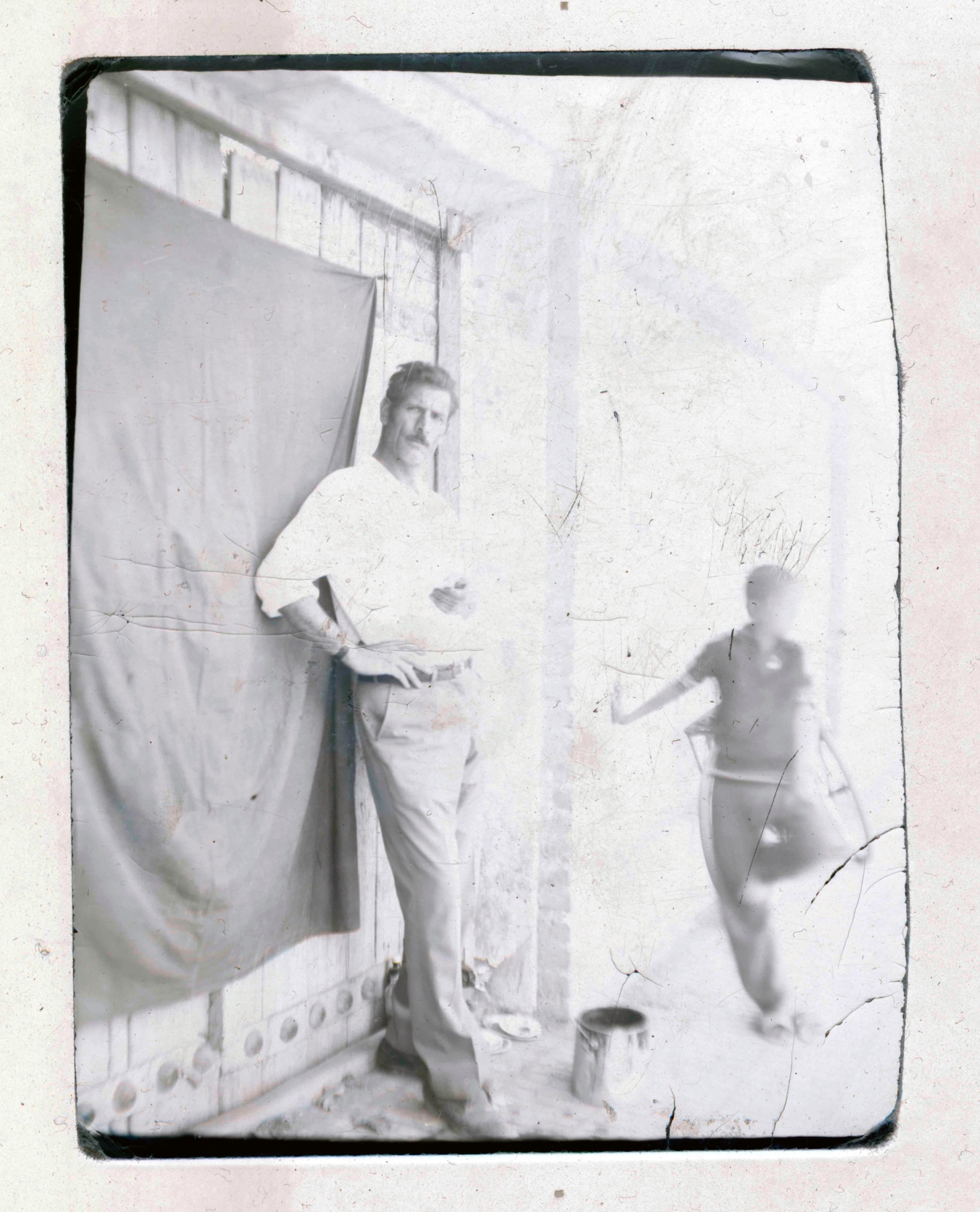
-
Shahram Khosravi, “The Life of an Itinerant Through a Pinhole,” Exhibition Catalogue. ed. Behzad Khosravi Noori. Tehran: Arran Gallery, 2016. p.52. ↩︎
-
Charlotte Bydler, “The Life of an Itinerant Through a Pinhole,” Exhibition Catalogue ed. Behzad Khosravi Noori. Tehran: Arran Gallery, p.44. ↩︎
-
Charlotte Bydler, “The Life of an Itinerant Through a Pinhole,” Exhibition Catalogue ed. Behzad Khosravi Noori. Tehran: Arran Gallery, p.45. ↩︎
-
Federico Fellini, Fellini on Fellini. ed. Anna Keel and Christian Strich; trans. Isabel Quigly. New York: Random House Publishing Group, 1977. ↩︎
-
Shahram Khosravi, Exhibition Catalogue. p.42. ↩︎
-
Shahram Khosravi, Exhibition Catalogue. p.43. ↩︎
-
Klaus Kreiser, “Die Derwische im Spiegel abend-ländischer Reiseberichte,” in Klaus Kreiser, Istanbul und das osmanische Reich. Derwischwesen, Baugeschichte, Inschriftenkunde. Istanbul: Isis Verlag, 1995. p.2. ↩︎
-
Thierry Zarcone, “Western Visual Representations of Dervishes from the 14th Century to Early 20th,” Kyoto Bulletin of Islamic Area Studies, 6 (March 2013). pp.43–58. ↩︎
-
See Mansur Shaki, “Darvîš,” Encyclopaedia Iranica. (Costa Mesa, California: Mazda Publishers, 1996), vol. VII. pp.72–73. ↩︎
-
Thierry Zarcone, “Western Visual Representations of Dervishes.” p.44. ↩︎
-
Ibid, p.45. ↩︎
-
Ibid, p.50. ↩︎
-
Victor Hugo, Les Orientales. vol 3. Paris: Charles Gosselin, 1829. pp.151–156. See Georges Thouvenin, “Le ‘Derviche des Orientales’. Les sources de Victor Hugo,” Revue d’histoire littéraire de la France, 37 (3 trimester 1930): pp. 347–367. ↩︎
-
This later became Acclimatation Anthropologique. ↩︎
-
Shahram Khosravi, Exhibition Catalogue. p.47. ↩︎
-
Film Farsi is a term used to describe popular films in Iran before the Revolution in 1978. They usually followed the same patterns of heroism, masculinity, love stories and erotic encounters. ↩︎
-
Asef Bayat describes this social agency as one of the main driving forces from the lower class during the 1978 Revolution. ↩︎
-
Eudora Welty, “Place in Fiction,” Collected Essays, New York: House of Books, 1957. ↩︎
-
Thierry Zarcone, Western Visual Representations of Dervishes, p.50. ↩︎
-
Rancière, The Future of the Image, London: Verso, 2007, p.112. ↩︎
-
Lukas Birk and Sean Foley, Afghan Box Camera Project. Dewi Lewis Publishing, 2011, From the project’s website https://www.afghanboxcamera.com ↩︎
-
The last factory-made camera of this type was the Jano While-U-Wait Postcard Camera, circa 1954. ↩︎